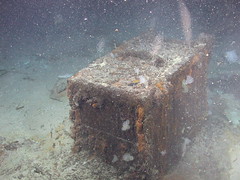
About UsThe Numismatic Bibliomania Society is a non-profit association devoted to the study and enjoyment of numismatic literature. For more information please see our web site at coinbooks.org SubscriptionsThose wishing to become new E-Sylum subscribers (or wishing to Unsubscribe) can go to the following web page link MembershipThere is a membership application available on the web site Membership Application To join, print the application and return it with your check to the address printed on the application. Print/Digital membership is $40 to addresses in the U.S., and $60 elsewhere. A digital-only membership is available for $25. For those without web access, write to: Terry White, Treasurer
AsylumFor Asylum mailing address changes and other membership questions, contact Terry at this email address: terrywhite5475@yahoo.com SubmissionsTo submit items for publication in The E-Sylum, write to the Editor at this address: whomren@gmail.com BUY THE BOOK BEFORE THE COINSale Calendar |
- WAYNE'S WORDS: THE E-SYLUM FEBRUARY 27, 2019
- ASYLUM SPRING 2019 ISSUE PUBLISHED
- NUMISMATIC LITERATURE IN HOLABIRD WIGWAM SALE
- NEW BOOK: PLEASURE AND PROFIT, 2ND EDITION
- NEW BOOK: COINS OF THE ENGLISH CIVIL WAR, 2ND ED.
- NEW BOOK: THE STORY OF SILVER
- MANHOLE COVERS AS NUMISMATIC OBJECTS
- JEFF ROCK ON THE MIDNIGHT SALE
- MORE ON THE THE IRA REED COINS
- NATIONAL SO-CALLED HALF DOLLAR HOLDERS
- ANOTHER EMANCIPATION PROCLAMATION DOG TAG
- EXPERT-LEVEL U.S. MEDALS CHALLENGE RESULTS
- NOTES FROM E-SYLUM READERS: FEBRUARY 24, 2019
- ANCIENT COIN SOURCE FOR LION VS. LION MEDAL?
- IN LETTERS WE TRUST: BANKNOTE TYPOGRAPHY
- SEATED FEST II BALTIMORE 2019
- VOCABULARY TERM: CHRONOGRAM
- AMOS F. ENO (1836-1915)
- HARVEY STACK'S NUMISMATIC FAMILY, PART 38
- MORE ON JIM KING
- MORE ON JOSH TATUM AND THE NICKEL GYP GAME
- BROOKLYN COIN CLUB PRESIDENT CHARLES H. RYAN
- THE MUSEUM OF AMERICAN FINANCE IS MOVING
- COUNTERFEIT 1893-S DOLLAR IN A FAKE PCGS HOLDER
- BLOOD-STAINED CURRENCY
- THE GREAT AMERICAN COIN HUNT
- AUSTRALIA'S DOLLAR DISCOVERY CONTEST
- MEDAL SELECTIONS FROM HEDLEY BETTS
- NUMISMATIC NUGGETS: FEBRUARY 24, 2019
- HOLABIRD MARCH 2019 WIGWAM SALE SELECTIONS
- ARCHIVES INTERNATIONAL SALE 51
- TOM KAYS' NUMISMATIC DIARY: FEBRUARY 24, 2019
- WARWICKSHIRE ROMAN SILVER DENARII HOARD
- SECRET DRAWER FIND: 14TH CENTURY GOLD COIN
- NUMISMATICS IN VICTORIA
- THE STOCKBRIDGE STELLA ORIGIN STORY
- U.S. MINT ENDS PRODUCTION OF 90% SILVER COINS
- THE EURO'S IMPACT ON NUMISMATICS
- WOMEN'S SUFFRAGE MEDALLIC ART COMPETITION
- ARIZONA ASSAY OFFICE INGOTS
- $11 BILL: $10/$1 DOUBLE DENOMINATION ERROR
- THE TIN CAN CASE: WHO OWNS BURIED TREASURE?
- PETOLS: THE SILVER CURRENCY OF CANNABIS COUNTRY
- DISCOVERING DNA IN OLD BOOKS
- THE OTTO PENZLER COLLECTION
- LOOSE CHANGE: FEBRUARY 24, 2019
- FEATURED WEB PAGE: TOP 11 WEBSITES
Click here to access the complete archive
To comment or submit articles, reply to whomren@gmail.com
Content presented in The E-Sylum is not necessarily researched or independently fact-checked, and views expressed do not necessarily represent those of the Numismatic Bibliomania Society.
WAYNE'S WORDS: THE E-SYLUM FEBRUARY 27, 2019
 Other topics this week
include the Ira Reed REEed coins, another Emancipation Proclamation dog tag, banknote typography, chronograms, Amos Eno, Jim King, Charles Ryan, the Museum of
American Finance, blood-stained money, the Euro's impact on numismatics, Arizona Assay Office ingots, and a fabulous double denomination paper money
error.
Other topics this week
include the Ira Reed REEed coins, another Emancipation Proclamation dog tag, banknote typography, chronograms, Amos Eno, Jim King, Charles Ryan, the Museum of
American Finance, blood-stained money, the Euro's impact on numismatics, Arizona Assay Office ingots, and a fabulous double denomination paper money
error.
To learn more about the coinage of San Serriffe, coins of the English Civil War, the Pennsylvania Blind Institution award medal, "Opium Coins", Seated Fest II, the unique 1870-S Half Dime, a counterfeit 1893-S Morgan dollar, Dassier's medal, the 1670 British Colonization medal, Victorian model coins, and the silver Petols of cannabis country, read on. Have a great week, everyone!
Wayne Homren
Editor, The E-Sylum
ASYLUM SPRING 2019 ISSUE PUBLISHED
The latest issue of our print journal The Asylum is on the way to the mailboxes of Numismatic Bibliomania Society members. Here is the table of contents and a message from our President Tom Harrison. A great lineup of articles! -Editor
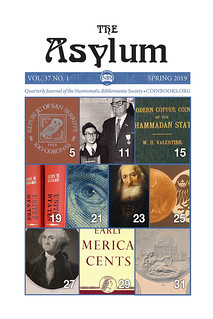 The Asylum
The Asylum
Vol. 37 No. 1
Spring 2019
Table of Contents:
• The Coinage of San Serriffe By Pete Smith
• Raised as a Numismatist by Aaron Oppenheim
• Valentine's Day By David Pickup
• United States Numismatic Literature and a Surprising Find By Cole Hendrickson
• Intaglio Printing & Wiping Paper By Bob Bednar
• "The Coin Collector" By Ray Williams
• My Dad, His Bank and How to Start Collecting Coins By David Pickup
• A Casual Discussion at the ANS: A follow up to "An Afternoon at Princeton University" By Ray Williams
• The Sheriff and the Switcher: An Afternote By Joel J. Orosz
• Lauer's Musterkarte 28: Within a Rare Catalog, an Even Rarer One By David D. Gladfelter
Message from the President
By Tom Harrison
Welcome to the first issue of The Asylum for 2019 that celebrates the 40th anniversary of the Numismatic Bibliomania Society. This being an odd numbered year, it is time to call for nominations for officer and board positions in the upcoming NBS election. If you have an interest in serving please email Maria Fanning at nbsasylum@gmail.com by May 1st so you may be included on the ballots to be mailed with the summer issue of The Asylum. Please also include a brief bio and photo to include with the nominations.
To celebrate the 40th anniversary of the NBS we are issuing a special summer edition of The Asylum to record your recollections of past NBS events such as live literature auctions, the invasion of Louisville or Pittsburgh, and any stories related to numismatic literature gatherings. We would enjoy hearing about weekend visits to fellow NBSers' libraries or an entertaining dinner rendezvous. Your remembrances of the fascinating personalities of our hobby are welcome whether they are a couple of paragraphs or several pages in length. Also, any photos you would be willing to share will be appreciated and greatly enhance this commemorative issue. As much as we enjoy reading about our numismatic forefathers, I believe current as well as future bibliophiles will be entertained by your stories that bring to light the events and personalities of the first forty years of the NBS in this time capsule. Think of it as passing your fond NBS memories forward. Thank you for your contributions that will record stories that might otherwise be forgotten.
With spring just around the corner, it is not too early to make plans for our annual gatherings at this year's ANA World's Fair of Money in Rosemont. We are looking forward to seeing many friends, old and new, at our Symposium, General Meeting and club table. Last year's benefit auction held at the General Meeting was a resounding success, not only in terms of the financial results, but also by the markedly increased number of generous donors and bidders. Again this year we are asking for donations for our benefit auction that will play a crucial role in the continued success of the NBS.
Even if you are unable to attend the convention, please consider this all-important opportunity to support your NBS. David Fanning has graciously offered to accept donated items and create a catalog for the auction. Your donations can be sent to Kolbe & Fanning, 141 W. Johnstown Road, Gahanna, Ohio 43230. The deadline for receiving donations is June 15, 2019.
A numismatic literature display is another way to promote our hobby and showcase your favorite title or author. This year's registration deadline is June 15th. This gives you ample time to create an educational exhibit at this year's premier numismatic event.
Finally, please know that as we embark on our 40th year your support and contributions to this remarkable organization are sincerely appreciated! Each article to The Asylum, donation to our benefit auction, or literature display at the ANA significantly enriches your NBS. May your numismatic library provide investigation, discovery and most of all, enjoyment.
Remember, while The E-Sylum is free to all, only paid members of the Numismatic Bibliomania Society receive our print journal, The Asylum. Print/Digital membership is $40 to addresses in the U.S., and $75 elsewhere. A digital-only membership is available for $25. -Editor
To join NBS, see:
https://www.coinbooks.org/club_nbs_member_app.html
NUMISMATIC LITERATURE IN HOLABIRD WIGWAM SALE
There are no major numismatic literature sales going on this week, but I noticed some group lots in the March 2019 Holabird Wigwam sale including titles on California gold, Carson City Mint history, Civil War numismatics, as well as hardbound Token and Medal Society journals. -Editor

To view the complete auction, see:
Wigwam Auction--March 2019
(https://holabirdamericana.liveauctiongroup.com/Wigwam-Auction-March-2019_as57512)
NEW BOOK: PLEASURE AND PROFIT, 2ND EDITION
A new edition of Robert Shippee's Pleasure and Profit: 100 Lessons for Building and Selling a Collection of Rare Coins has been published by Whitman. -Editor
Robert Shippee's Award-Winning Memoir
on Collecting and Investing in Rare Coins
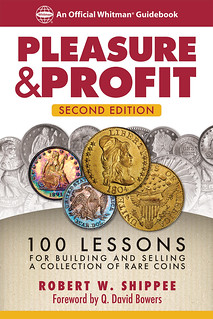 Whitman Publishing announces the release of the second edition of Pleasure and Profit: 100
Lessons for Building and Selling a Collection of Rare Coins, by Robert W. Shippee. The 328-page book will debut at the Whitman Coin & Collectibles
Baltimore Expo, February 28, 2019. After that it can be ordered from booksellers and hobby shops nationwide, and online (including at Whitman.com), for $19.95
retail.
Whitman Publishing announces the release of the second edition of Pleasure and Profit: 100
Lessons for Building and Selling a Collection of Rare Coins, by Robert W. Shippee. The 328-page book will debut at the Whitman Coin & Collectibles
Baltimore Expo, February 28, 2019. After that it can be ordered from booksellers and hobby shops nationwide, and online (including at Whitman.com), for $19.95
retail.
In Pleasure and Profit, longtime collector Robert Shippee reveals how he carefully assembled a meaningful collection of rare coins. His Waccabuc Collection of half cents through $20 gold double eagles sold at public auction for a profitable $1.5 million. Pleasure and Profit gathers the lessons he learned from buying and selling each of the nearly 150 coins.
Shippee provides real-world advice to guide other collectors on acquisition strategies, storage choices, and disposition options, in addition to commentary on auction firms, third-party grading services, famous dealers, numismatic personalities, market forces, and-with unflinching honesty-his laid-bare financial results.
"Pleasure and Profit is one of Whitman's most talked-about books on collecting and investing in U.S. coins," said publisher Dennis Tucker. "Many hobbyists have told me, 'I wish I'd had a guide like this when I started collecting.'"
The first edition earned the "Best Specialized Book on Numismatic Investments" award from the Numismatic Literary Guild.
In the second edition Shippee updates the market reports on nearly all of the coins in his case-study collection. He expands his discussion of rare-coin indexes, and his comparison of coins vs. the stock market. And he makes a new analysis of his coins by denomination, tracking where they would be, value-wise, a decade-plus after their sale.
"With greater knowledge comes greater confidence as a collector," Shippee says. "My hope is you can learn from my successes-and just as much from my mistakes."
Q. David Bowers, past president of the Professional Numismatists Guild, calls Pleasure and Profit "one of the most useful books in American numismatics."
Pleasure and Profit: 100 Lessons for Building and Selling a Collection of Rare Coins, 2nd edition
By Robert W. Shippee; foreword by Q. David Bowers
ISBN 0794847137
Softcover, 6 x 9 inches, 328 pages, full color
Retail $19.95 U.S.
https://www.whitman.com/store/Inventory/Detail/Pleasure-and-Profit-2nd-Edition-+0794847137

NEW BOOK: COINS OF THE ENGLISH CIVIL WAR, 2ND ED.
SPINK has published a new release of Edward Besly's book, Coins and Medals of the English Civil War. -Editor
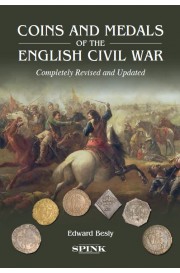 Coins and Medals of the English Civil War by Edward Besly
Coins and Medals of the English Civil War by Edward Besly
Second edition - completely revised and updated
Hardback, jacketed
232 x 155mm
260pp
RRP £40
ISBN: 978-1-912667-01-7
The second edition of this book presents a new and expanded exploration of the unusually varied coinage and currency of the 'Great Rebellion' of 1642-1660, a pivotal period in British history. It builds on further research available since its original publication in 1990, notably a fresh appraisal of the West Country mints of Sir Richard Vyvyan and new insights into the numerous hoards of the time. Along the way, we meet more of the people who willingly or unwillingly did business with the wartime mints.
Following a description of the currency in circulation in 1642 and a survey of the organisation of royalist minting during the war, the royalist mint-franchises are considered in turn. Foreign coinage, siege issues and the emergency coinages of Ireland are all described; and the story of the Tower Mint under Parliament is followed through the Interregnum of 1649-60 to the Restoration of Charles II. Minting methods at a time of transition from manual to mechanised production form an important subsidiary theme.
Edward Besly was Numismatist at the National Museum of Wales (Amgueddfa Cymru) from 1986-2018, having previously worked at the British Museum. He is best known for his studies of Romano-British coin hoards and of the coinages of the time of Charles I (1625-49). In 2003 he was awarded the John Sanford Saltus Medal of the British Numismatic Society.
For more information, or to place an order, visit our website: https://spinkbooks.com/ .
NEW BOOK: THE STORY OF SILVER
A new book on the history of silver was reviewed in the Wall Street Journal February 20, 2019. Here's an excerpt. -Editor
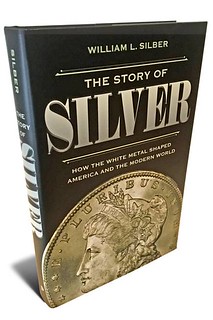 We all want
dollars, but who can define that object of desire? It was easy in 1792. Alexander Hamilton declared that the dollar was a unit of account weighing 371.25
grains of pure silver, and death was the penalty for debasing it. "The Story of Silver" is the biography of America's first monetary metal.
We all want
dollars, but who can define that object of desire? It was easy in 1792. Alexander Hamilton declared that the dollar was a unit of account weighing 371.25
grains of pure silver, and death was the penalty for debasing it. "The Story of Silver" is the biography of America's first monetary metal.
Biography is the word, as William Silber's colorful narrative is one of personalities as much as it is of ideas and events. Like gold, silver can preoccupy its fans to the point of obsession, as it did the Hunt brothers, Texas inflation-phobes who lost a fortune in 1980 by betting on silver and therefore against Paul Volcker, then chairman of the Federal Reserve, and Mr. Volcker's sky-high interest rates.
In 1873, Sen. John Sherman, an Ohio Republican, sponsored legislation to strike silver from America's monetary rolls, relegating it to small change and silver dollars. So dry was the author's legislative draftsmanship that nobody seems to have penetrated it. Unmistakable, however, was the subsequent plunge in the silver price and the resulting howls of the impoverished miners. The "Crime of '73," they called Sherman's Coinage Act, though the crime was arguably the failure of his congressional colleagues to read the bill. Mr. Silber blames Sherman for "a great deflation in the United States during the last quarter of the nineteenth century."
Or perhaps he should blame human progress. The 1885 Report of the Commissioner of Labor relates that, in a certain factory six years earlier, 17 skilled men had produced 500-dozen brooms a week. By 1885, in the same, now-mechanized factory, nine men turned out 1,200-dozen brooms a week. Presumably broom prices declined because it cost less to make them, not because there was too little silver in the customers' pockets. The voters seem to have agreed that life was getting better, not worse. At least, William Jennings Bryan, a Democrat running for president in 1896 on a pro-silver, pro-inflation platform, lost to William McKinley, the Republican gold-standard champion.
Mr. Silber's 20th-century cast of characters features Henry Morgenthau, secretary of the Treasury under Franklin D. Roosevelt, who carried out presidential orders to raise the price of silver and thereby placate the Western silver bloc...
He's on firmer ground in describing the great silver-coin famine of the 1960s. No mystery here; the coins disappeared into vaults when the silver value of a dime topped the stated 10 cents, or of a quarter, the stated 25 cents. (For a less fervid account of this episode, see William F. Rickenbacker's 1966 book, "Wooden Nickels.")
The best and longest section of "The Story of Silver" concerns the Hunt brothers' blameless purchase of 200 million ounces of silver to protect against the depreciating paper dollar (as they maintained) or their criminal conspiracy to corner the world silver market (the government's contention). Either way, Nelson Bunker Hunt, leader of the family triumvirate, rode the silver price from a few dollars an ounce to $50 an ounce and most of the way back down again. Losses reached the billions.
I can't help but be impressed by a reviewer aware of such an obscure book as Wooden Nickels, one I've had on my library shelf for many years. -Editor
To read the complete article (subscription required), see:
'The Story of Silver' Review: The Other Precious
Metal (https://www.wsj.com/articles/the-story-of-silver-review-the-other-precious-metal-11550705603)
MANHOLE COVERS AS NUMISMATIC OBJECTS
In the let's-see-ya-slab-THAT-department is this report from Newman Numismatic Portal Project Coordinator Len Augsburger on some amusing content found on the site. Thanks. -Editor
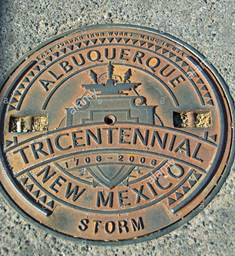 A tongue-in-cheek presentation delivered by Gerry Tebben at the February 2019
Central Ohio Numismatic Association (CONA) meeting makes a convincing case that manhole covers should be considered as numismatic objects. Tebben makes the
point that they are round, often dated, and have intrinsic value as bullion products. Further, many of these serve artistic and commemorative purposes that are
not always apparent at first glance, and in this sense manhole covers could well be considered "very large medals."
A tongue-in-cheek presentation delivered by Gerry Tebben at the February 2019
Central Ohio Numismatic Association (CONA) meeting makes a convincing case that manhole covers should be considered as numismatic objects. Tebben makes the
point that they are round, often dated, and have intrinsic value as bullion products. Further, many of these serve artistic and commemorative purposes that are
not always apparent at first glance, and in this sense manhole covers could well be considered "very large medals."
Tebben discusses approaches to collecting manhole covers, and advocates for a split grading system, since most exhibit environmental damage on one side. As slabbing is not yet commercially available, Tebben explores considerations for storage and preservation. The presentation is surprisingly compelling, but might have been more in keeping with an April 1st meeting date.
Image: Attractively-toned Albuquerque Tricentennial (2009) commemorative manhole cover
Link to Central Ohio Numismatic Association (CONA) presentations on Newman Portal:
https://nnp.wustl.edu/library/publisherdetail/525609
Link to Central Ohio Numismatic Association (CONA) newsletters on Newman Portal:
https://nnp.wustl.edu/library/publisherdetail/525608
JEFF ROCK ON THE MIDNIGHT SALE
Jeff Rock submitted these recollections about the famous 1991 EAC "Midnight Sale". Thanks! -Editor
 The sale happened only because we were in Boston for the 1991 EAC convention and Mike Ringo had gotten into town
a few days earlier, hitting one of the local coin stores that had a bid board (Worthy Coin). He purchased a couple large group lots of lower-middle grade
Connecticut coppers, and a group of us were in Robert Martin's room, some of us helping to attribute, others partaking of a substance that is now
quasi-legal in some of the more liberal states.
The sale happened only because we were in Boston for the 1991 EAC convention and Mike Ringo had gotten into town
a few days earlier, hitting one of the local coin stores that had a bid board (Worthy Coin). He purchased a couple large group lots of lower-middle grade
Connecticut coppers, and a group of us were in Robert Martin's room, some of us helping to attribute, others partaking of a substance that is now
quasi-legal in some of the more liberal states.
Robert asked Mike if he was going to put the coins on a price list and I piped up "Hey, kids, let's put on an auction!" Perhaps it was the haze in the room, but everyone got on board. Walter Breen was there (thus the haze), and we pressed him to catalogue the coins -- but he did not exactly work quickly, and I jumped in and had my first experience of writing auction catalogue descriptions (including the snarky ones). Of the 24 1/2 lots I wrote ten - any description not in Breen's distinct hand was mine. Ringo wrote the lot numbers and attributions for the pieces, save for the group lots which I attributed as we went along, and the name of the newly-christened auction company at the base of each ticket.
As we were putting the auction together, some in the group went around to the rooms of other collectors, pounding on doors to wake some of them up -- who really sleeps at a coin show, anyway? I think only one person preferred to sleep, and it was their loss because when the catalogue was printed -- many years AFTER the sale was actually held -- they didn't receive a copy. You gotta' be present to win. Mike called the auction, which was about as fun as one would expect for a sale that started well after midnight, especially as some of the bidders were actually found in the hotel bar, not their rooms. Of the 12 people present, 8 of us won at least one lot - a pretty high percentage by any auction standard!
After the sale I collected the original documents, including most of the lot tickets (one collector took his with his winnings), and they sat in my library for years. Rob Retz, who was at the sale, eventually decided it was time to do something about it and he set about putting the printed catalogue together, each copy with the recipient's name on the cover (we had two additional copies printed for people who weren't able to attend the sale - dealer Mary Sauvain who was at the convention but not someone we were sure would have been happy being woken up -- and Michael Hodder who wasn't at the show but was already a colonial deity and we presented him a copy as a token of our appreciation). Those handwritten lot tickets were tucked into a special pocket for each of the winning bidders.
Of the dozen people at the sale - all in the photograph you included -- 5 have sadly passed away: Walter Breen and Mike Ringo in the front row and Steve Tannenbaum, Robert Martin and Rob Retz in the rear row. Don Mituzas and Tom Rinaldo, next to me in the middle row are no longer active in the hobby, and of the remaining four people, all have scaled back their numismatic involvement from the "good old days."

Perhaps it was because I was the youngest one in the photo that I am still around - but seeing this picture reminds me of what has often been missing in the hobby: FUN! We all have the interest in historic items or else we wouldn't be collectors. But thinking back to what shows were like 25 years ago or more, things have certainly changed. The camaraderie and, yes, plain silliness that resulted in the Midnight Sale is often missing. Smaller, specialized groups like NBS, EAC and C4 are an exception to the overall mercenary trend of the hobby (where people who can read a slab company population report are suddenly considered "experts").
The Midnight Sale experience was fun, and we tried to repeat it -- twice. But it was like catching lightning in a bottle. We had another sale the following year which was held at an earlier hour and featured coins on consignment - and if memory serves all but one or two pieces were bought back by their owners, and no one wanted to do one again. Many years later, during the final C4 convention to be held in Boston (before moving to the Baltimore show in the autumn), collector Roger Siboni decided to resurrect the tradition, bringing in dealer Tom Rinaldo to write and call the auction. Despite Tom's wonderful quirkiness (including calling the auction while jumping on Roger's bed), the results were the same as the second attempt, with consignors mostly buying back their own material.
The original Midnight Sale was something unique, tied both to place and time, and with a cast of characters that has been sadly depleted -- it was great fun, but it is an experience that will never be replicated.
To read earlier E-Sylum articles, see:
MORE ON ROBERT MARTIN AND THE MIDNIGHT SALE
(https://www.coinbooks.org/v20/esylum_v20n48a17.html)
THE 1991 EAC MIDNIGHT SALE (https://www.coinbooks.org/v22/esylum_v22n06a04.html)
WORTHY COIN COMPANY START DATE (https://www.coinbooks.org/v21/esylum_v21n41a11.html)
DON CORRADO ROMANO (1903-1984) (https://www.coinbooks.org/v21/esylum_v21n40a12.html)

MORE ON THE THE IRA REED COINS
Regarding the 1937 REEDed edge cent and nickel produced by dealer Ira Reed, Editor Greg Burns provided this article by Sol Taylor from the Winter 2018 issue of The California Numismatist. Thanks! Great background info. -Editor
The Ira Reed Coins
by Dr. Sol Taylor
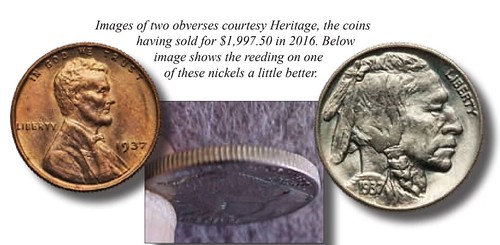
Dave Bowers offers this from his 2008 Guide Book of Lincoln Cents published by Whitman. Thanks! -Editor
Circulation mintage: 309,170,000
Proof Mintage: 9,320
Key to Collecting: Common in any and all grades desired. • Striking and Sharpness: Full Details coins are plentiful.
Proofs: These are readily available in proportion to the number minted. Many have been dipped, then later acquired spots, then were redipped. Pristine coins will always have gentle toning. No exceptions.
Notes: In 1941 at the American Numismatic Association convention held that year in Philadelphia, Ira Z. Reed, well-known Philadelphia dealer, offered for sale pairs of 1937 Lincoln cents and Buffalo nickels with reeded edges. These were sold as novelties, not as Mint products. Somehow, the intent of these was forgotten, and in time both were later listed as rarities in A Guide Book of United States Coins. In March 1960 in the auction James F. Kelly conducted for the Penn-Ohio Coin Convention, an example of the cent was offered with this misinformation presented as fact:
1937 rare "milled edge" variety. Unc. bright red. This cent and the nickel (Lot No. 276) were purchased at the 1941 Philadelphia ANA Convention. There have been many conflicting stories regarding this coin but it has been verified by none other than the late F.C.C. Boyd that the late Ira Reed obtained 300 sets of these coins from the Mint just prior to the Convention. This information is first-hand as I was at the convention, was well acquainted with Mr. Reed and Mr. Boyd and can vouch for the above statements. It is a rare coin with auction records close to $100.
This phony description resulted in the "rare" cent bringing $35, and is perhaps a good lesson that a "first hand" recollection can become erroneous when reported years later! Such stuff provides fodder for numismatic students and researchers, who now in the early 21st century are more numerous and enthusiastic than any other time in the history of the hobby.
Writing in The Numismatist, April 1940, Stephen Teets commented: "There is a small 7 and a large 7 on our 1937 Lincoln cents. The former is very small and can be easily discerned. I have been able to locate only one specimen of the small 7 type." Perhaps this was from a relapped die or other process which made a regular 7 seem small. Only one date size is recognized today.
I never noticed the 1937 reeded edge listings in the Redbook. One of those original Ira Reed cards would be a great piece of numismatic ephemera with or without the attached coins. Does anyone have one? It would be nice to get a photo of one. -Editor
To read the earlier E-Sylum article, see:
1937 "REEDED EDGE" NICKEL AND CENT
(https://www.coinbooks.org/v22/esylum_v22n07a20.html)
NATIONAL SO-CALLED HALF DOLLAR HOLDERS
Researcher Dave Lange submitted these thoughts on storage solutions for so-called half dollars. Thanks. -Editor

So-called Half Dollars Salesman's Sample Set
The National coin holder with so-called half dollars that was illustrated in last week's issue caught my eye. It's an example of Publisher Number 420, my Lange Number RNSU7a, which was unprinted and intended for storing coins or medals of 32mm diameter. The National line actually produced a dedicated holder for a selection of so-called half dollars during the 1950s and early '60s, and I'm attaching images borrowed from eBay. This holder is Publisher Number 349Y, Lange Number RNSCA17.
Series 349 holds a complete date/mint/variety set of United States commemorative silver coins 1892-1954. Pages 349A through 349O are for the half dollars, 349X holds the 1893 Isabella Quarter, the 1900 Lafayette Dollar and several commemorative medals: the 1920 Manila Mint Opening, the 1935 Pony Express Jubilee, the 1925 Norse American Centennial (silver---thick and thin editions) and the 1938 Swedish commemorative two-kronor piece commemorating New Sweden.
These are all issues that Wayte Raymond promoted heavily as being part of a USA commemorative coin collection, though he clearly overlooked the USA-Philippines Commonwealth coins of 1936. Interestingly, both 349X and 349Y include the Pony Express medal, and the reason for this redundancy is unknown. From ads of the period it appears that 349Y typically was sold with the medals/coins already in place, and it's unusual to find that page without them in the secondary market.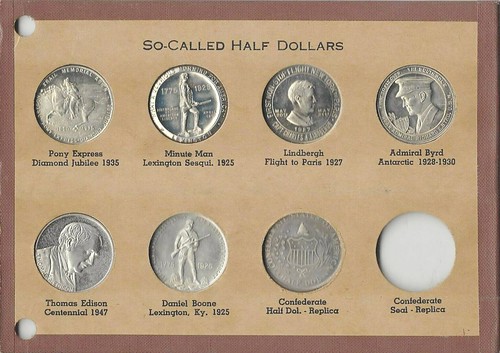
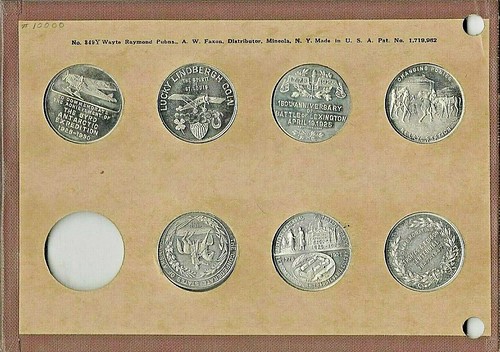
To read the earlier E-Sylum article, see:
WAYNE'S NUMISMATIC DIARY: FEBRUARY 17, 2019
(https://www.coinbooks.org/v22/esylum_v22n07a18.html)
ANOTHER EMANCIPATION PROCLAMATION DOG TAG
Alex Lynn writes:
I was delighted and intrigued to see the Emancipation tag contributed by John Kraljevich in the February 3rd issue. As John eloquently put it, in addition to their usual celebration of both famous and infamous, coins (and coin-like objects) can sometimes identify "triumphs amid struggle," and touch upon the stories of those whose stories often go untold.
I've owned this piece (see attached photo) for about twenty years. I've held onto it as something that was obviously truly special, and which spoke to a profound struggle. It's always struck me as a very powerful object. Needless to say, I was pretty stunned to see the piece that John contributed, named to Dennis Addison. It's almost certainly made by the same hand that made this tag for Mr. Edward Wood, bearing the same date, that of the Emancipation Proclamation, January 1st, 1863.
I've tried in vain to research Edward Wood several times over the years, without finding anything. This tag is extremely worn, but the lettering is virtually identical to the Dennis Addison tag. Who made these? I had always assumed that the one I have was a one-off, but clearly it's not. The mystery of these pieces deepens! It's amazing how much there's still to learn.
Thanks so much for sharing this with us. What a great piece! Below is Alex's Edward Wood piece followed by John's Dennis Addison one. How many more are out there waiting to be discovered? -Editor
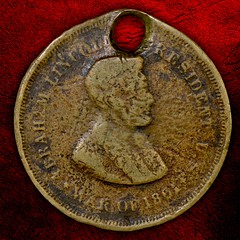
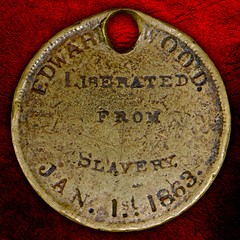

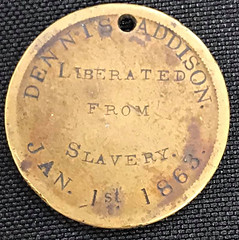
To read the earlier E-Sylum article, see:
EMANCIPATION PROCLAMATION DOG TAG (https://www.coinbooks.org/v22/esylum_v22n05a15.html)
EXPERT-LEVEL U.S. MEDALS CHALLENGE RESULTS
Last week Jonathan Brecher submitted a tough challenge for our readers. -Editor
I think that anyone short of an expert will have a hard time answering more than one or two of these questions. But we've got some experts here! Let's see how folks do, or if I've come up with a stumper. :-)
I'm showing the wreaths on the reverses of four different US medals. Three of these I've had for a while; the fourth one is a new purchase. And a jaw-dropper of a purchase also - but for reasons that are not exactly related to this challenge and that I'll reveal afterwards. For now, give this a shot:
1. Besides obvious trivial details (They're all round! They're all silver! They all have wreaths on them!), what do the four medals have in common? [difficult]
2. Identify each medal:
* A (30.5 mm): [difficult]
* B (30.5 mm): [expert-plus]
* C (36.1 mm): [expert]
* D (36.1 mm): [expert-plus]

Mystery medal A reverse
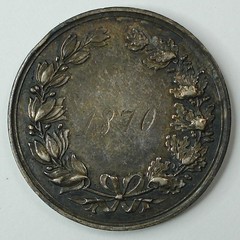
Mystery medal B reverse
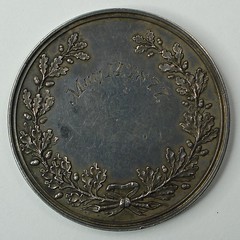
Mystery medal C reverse
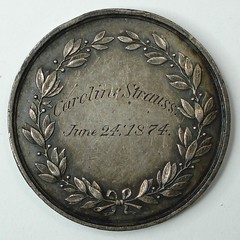
Mystery medal D reverse
Pete Smith writes:
I have spent a couple of hours trying to identify the medals in Jonathan BrecherI's challenge. So far I have been unsuccessful. Perhaps the thing they have in common is that they are all award medals that have no previously published photo.
I started by looking through Julian, Medals of the United States Mint. An example is Julian SC-32, a 36 mm medal with reverse described as "Wreath around open field." I have not been able to find a photograph of the reverse. There are several other Julian medals of the correct size with a wreath reverse and no photograph. I suppose those could be called published, but they are impossible to identify. How is someone who does not own the medals supposed to make the identification?
I haven't given up, but I have gotten frustrated.
PeteI's right to be frustrated - it takes a dedicated collector with his own handy-dandy reference collection to answer this one. -Editor
John Sallay writes:
The first medal (A) looks very familiar, but I just can place it. It will probably be doubly embarrassing for me once Jonathan confirms the answers to the challenge and I'm reminded that I have one in my collection, but just couldn't remember it.
The other three are all U.S. Mint medals, and school award medals at that:
B) Iowa State University, SC-26
C) Jefferson Medical College, SC-27
D) Pennsylvania Institution for the Instruction of the Blind, SC-32
My guess on the common thread is that Jonathan found them all on eBay and paid only a few dollars for each, even though they are all very rare, desirable, and valuable American medals. He's a collector's collector, absolutely amazing in what he is able to find! I can hardly wait to hear the jaw-dropping follow-up.
On the PCGS Forum Daniel Carr writes:
They all have a stepped rim, consistent with (but not limited to) 19th Century US Mint medals.
OK - here are JonathanI's answers. -Editor
I got a laugh out of Pete SmithI's guess that these are all medals with no previously published photos. That would have been hilarious, at least for one of us! But no, at least two of these have been published, and PeteI's instincts to look in Julian were spot on.
Dan CarrI's response is fascinating. I didn't notice that at all, and I'd never noticed that was a feature of US Mint medals. He got to the right answer that they're US Mint medals
Kudos to school medal collector John Sallay for identifying three of the four medals. And the one he didn't identify wasn't a school medal, so itI's understandable why he missed that one.
All four of these are US Mint medals listed in Julian. In order, they are:
Julian CM-3. The obverse of this medal is more commonly paired with a text-heavy reverse that features an Oath of Allegiance (CM-2). The wreath reverse is unpictured in Julian but several examples have been sold over the past few years.
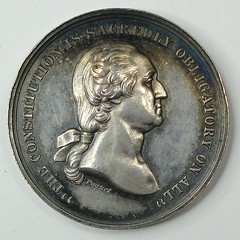

Mystery medal A: Julian CM-3
Julian SC-26, the Iowa State University award medal. This is a very, very rare medal. Julian could not find an example to picture in his book, knowing of it only from the mint records and a surviving obverse die. He writes, "There may be a reverse for this medal, as Irish paid $75 for the dies, which seems high for just one lettered die." Yes, there was a reverse!


Mystery medal B: Julian SC-26 - Iowa State University award medal
Julian SC-27, the Toner medal for Jefferson Medical College. This is pictured in Julian, where it listed as 32 mm. This is also a very rare medal, so much so that I don't have an example. I'm showing the pictures from Julian instead. The 1986 Dreyfuss sale included an example that confirms that the diameter is actually 36 mm and that the smaller size reported in Julian is incorrect. If you think itI's odd that I can show you the reverse in the original challenge while also saying that I can't show you the obverse of the actual medal here… keep reading!
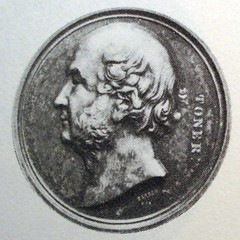
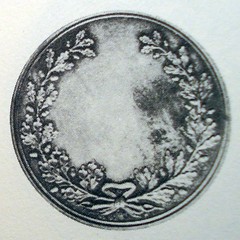
Mystery medal C: Julian SC-27 - the Toner medal for Jefferson Medical College
Julian SC-32, the Pennsylvania Blind Institution award medal. This is another very, very rare medal. Julian has a photo of the obverse but not of the reverse.
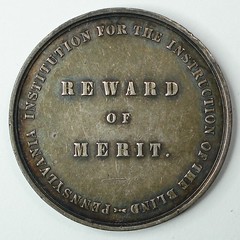

Mystery medal D: Julian SC-32 - the Pennsylvania Blind Institution award medal
When I posed this challenge, I thought that someone might be able to identify CM-3. ItI's rare but not impossibly rare, and the wreath is fairly distinctive. From there, someone could realize that all of these have the "look" of US Mint medals of this period, and get a plate match to the photo of SC-27 in Julian. The other two (SC-26 and SC-32) are so rare and unpictured in Julian; it would have taken some doing for anyone to identify those without having examples of their own like John has.
All of this brings us back to medal C. This was my recent purchase. I bought it online with one other piece, because it looked odd. I didn't think much about it when I bought it, or when I opened the package. Then I looked at it again. And I looked at the piece that came with it. And then I realized what I was looking at and my jaw hit the floor. (And then it took me 15 minutes to button everything down and confirm my hunch!)
This is medal C again, on the left, and its flip side on the right. Look familiar? The piece I bought is a mule of the reverses of Julian SC-27 and SC-32. This is unlisted. As far as I know, itI's also unprecedented. There are many mules known of the larger US Mint medals in the MI- and NA- series. Also, some of the obverse dies were intentionally struck with several different reverses, such as the series of dated medals for the Massachusetts Charitable Mechanics Association (Julian AM-34 through AM-41) with the same obverse and different reverses in different years. This may be the first example of a mule of two different small-size award medal dies originally intended for other US Mint medals, repurposed as a totally new award medal. This wasn't even on my radar as something that might possibly exist.
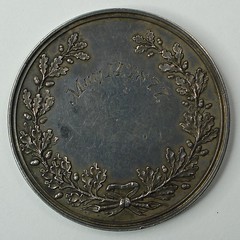
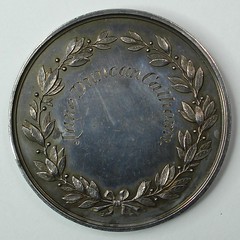
mule of the reverses of Julian SC-27 and SC-32
The other piece I bought with this? It is of course a mule of the reverses of CM-3 and SC-26.
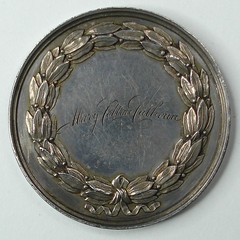

mule of the reverses of CM-3 and SC-26
Normally I'm skeptical when anyone claims to have found an unlisted US Mint medal. In this case, I'm calling it. We have four dies that are known to produce US Mint medals, and only known to produce US Mint medals, now seen in two pairs of struck mules. These have got to be legitimate (if clandestine!) US Mint medals as well.
…and if you're still in doubt, thereI's the matter of the recipients. Medals of this type are normally called award medals, for the very obvious reason that they were normally awarded as prizes. It looks like my mules were also awarded, to Mary Colton Calhoun on January 18, 1871 and to Jane Duncan Calhoun on May 14, 1877. Appearances can be deceiving - those aren't award dates! Mary Colton Calhoun and Jane Duncan Calhoun were the second and third daughters of James Richardson Calhoun and Marie Louis Barth. Those are their BIRTH dates. The Calhouns lived in Philadelphia (huh!), specifically in the 10th district of the 3rd ward, which (of course!) is the ward that contained the US Mint building. In the 1870 census James Calhoun is listed as a clerk of the US Asst Treas.
How about that!
Now that was tough! Thanks, everyone. -Editor
To read the earlier E-Sylum article, see:
EXPERT-LEVEL U.S. MEDALS CHALLENGE (https://www.coinbooks.org/v22/esylum_v22n07a16.html)
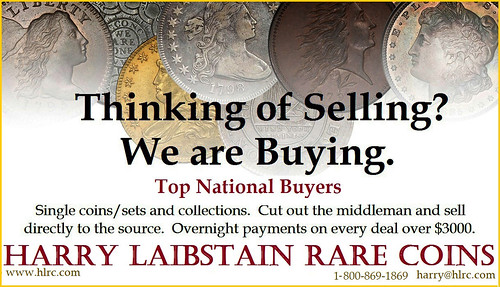
NOTES FROM E-SYLUM READERS: FEBRUARY 24, 2019
More on the SS Central America PurserI's Safe
Max Hensley writes:
I particularly liked the story on the SS Central America PurserI's safe. I wonder how they missed it the first time?
A simple question, and one I'm sure has a lengthier answer. I'll reach out to Bob Evans, who was part of both excursions to the shipwreck. -Editor
To read the earlier E-Sylum article, see:
SS CENTRAL AMERICA CASH BOX FINDS (https://www.coinbooks.org/v22/esylum_v22n07a15.html)
Artistic Numismatic Book Covers
Regarding artistic book covers, George Kolbe writes:
I have always liked the cover of Dye's Coin Encyclopedia. There is even a numismatic bibliography with a decoratively-stamped front cover.
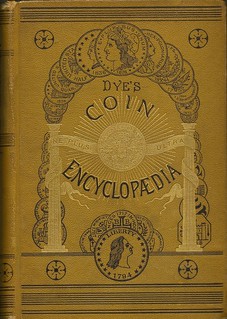

George provided the above image of the cover of Literaturnachweis über Geld-und-Münzwesen. The image of Dye's Coin Encyclopedia is one from my library. -Editor
To read the earlier E-Sylum article, see:
THE ART OF BOOK COVERS (https://www.coinbooks.org/v22/esylum_v22n07a29.html)
Walter Breen and "Opium Coins"

Dave Bowers writes:
There is no such thing as an opium Columbian half dollar, trade dollar, or any other late 19th century coin. Walter Breen made this up years ago. I reminded him that at the time anyone of any age could go into a drug store and buy all of the opium and derivatives they wanted. Breen also said that druggist R. Coulton Davis was able to get rare Mint restrikes and patterns by trading Mint officials laudanum (a derivative) for them. I won't mention Walter's "Midnight Minters" scenario he publicized and was widely accepted as factual at the time.
Indeed. Thanks. Like Dave Wnuck said, calling them Opium Coins sounds way cooler. Just doesn't make it true. -Editor
To read the earlier E-Sylum article, see:
NUMISMATIC NUGGETS: FEBRUARY 17, 2019 : 1892 Columbian Half Dollar "Opium Coin".
(https://www.coinbooks.org/v22/esylum_v22n07a17.html)
Whatever Happened to Don Taxay?
Pete Smith writes:
Whatever happened to Don Taxay has been one of the great numismatic mysteries of our time. Even his biography on the Newman Numismatic Portal did not have his full date of birth. That has now been fixed.
Donald Paul Taxay was born in Chicago on May 24, 1933. His parents were Julius Taxay and Ruth Weller. This is recorded with Cook County birth certificates. He had a sister Ruth who was seven years older.
He may have lived in Stamford, Connecticut as recently as 2008. He was connected with Rare Coin Collectors Co-Op, Inc. at 700 Summer Street in Stamford. I don't know the source for the report that he was still there in 2008.
For those not familiar with the story, Taxay disappeared from the known numismatic world around 1977. I have provided the start to the Taxay story. Who can bring it up to date?
ANCIENT COIN SOURCE FOR LION VS. LION MEDAL?
Last week, William Todd wrote:
Below is a photo of a 1917 cast iron medal by the Hungarian-born Munich medallist Elisabeth von Esseö (also spelled Essoe, as on this medal) in my collection. The image of these fighting lions is reminiscent of an ancient (Hellenistic?) coin, but thus far my online searches have failed to discover an original which she may have used as a source.
I would be grateful if any reader familiar with Classical numismatics could provide a photo, or link to a photo, of such an image along with relevant data.
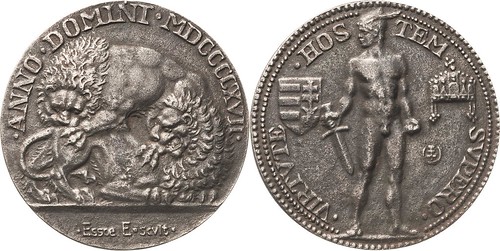
Deven Melton writes:
The ancient coin that inspired the pictured 1917 medal was likely a Acanthus Tetradrachm. Here's a link of sold Heritage lots.
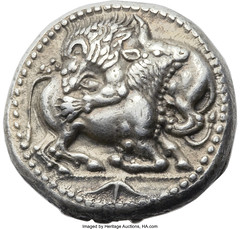
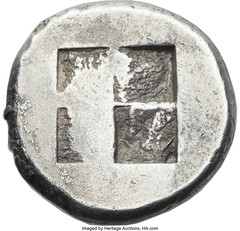
MACEDON. Acanthus. Ca. 520-470 BC. AR tetradrachm (26mm, 17.28 gm). Bull with head raised crouching to right, attacked by lion, leaping left on his back; Acanthus flower in exergue / Quadripartite incuse square. J. Desnaux, Les tétradrachmes de Akanthus, cf. pl. VI, 14. Boston 516. Gulbenkian 391.
To view the lot descriptions, see:
https://www.ha.com/c/search-results.zx?N=790+231&Nty=1&Ntt=Macedon+acanthus+Tetradrachm&Ntk=SI_Titles-Desc&ic10=OtherResults-ViewAll-071515
OK. ThatI's lion vs. bull, but is there a coin with a lion vs another lion? Ron Haller-Williams submitted a number of links (too many to publish here). He came up with some lion vs. bull designs as well, but he hasn't found a lion-on-lion design, either. HereI's one of his other finds. -Editor
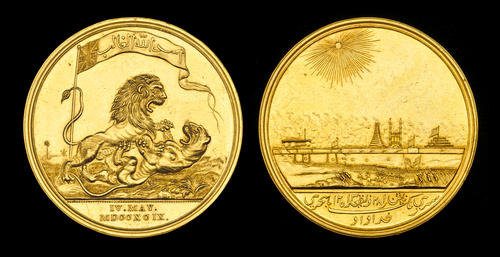
Lion vs. Tiger: The Seringapatam Gold Medal
To read the complete article, see:
Tipu Sultan and the Seringapatam Medal
(http://www.omsa.org/tipu-sultan-and-the-seringapatam-medal/)
To read the earlier E-Sylum article, see:
NOTES FROM E-SYLUM READERS: FEBRUARY 17, 2019 : Query: Ancient Coin Source for 1917 Medal
(https://www.coinbooks.org/v22/esylum_v22n07a09.html)
IN LETTERS WE TRUST: BANKNOTE TYPOGRAPHY
Kavan Ratnatunga writes:
A friend working in typography sent me a great video by Frere-Jones who shows the potential there is to do some very interesting research on the typography on old BankNotes.

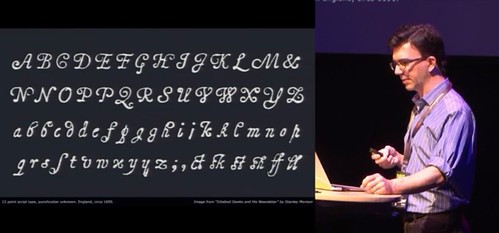
This talk presents ongoing research into the use of letterforms as a means of security for citizens and governments alike, thwarting forgery in plain sight and in secret. Some strategies have relied on high-profile collaborations, and others on home-grown cunning. Interwoven is a story of war and peace, technology, culture and economics. The narrative will focus on American banknotes from the Colonial period to the present day, with additional examples of government permits and lottery tickets.
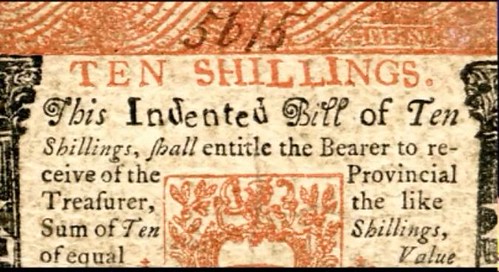
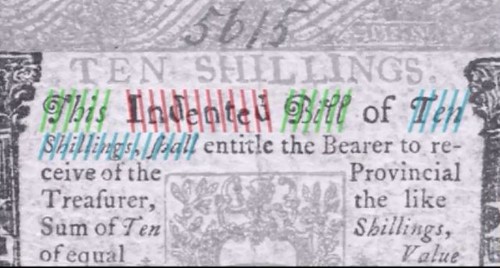
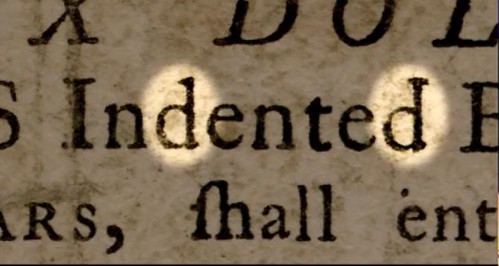
Kavan adds:
I recently found an inverted N on the 1850 1 pound watermark.

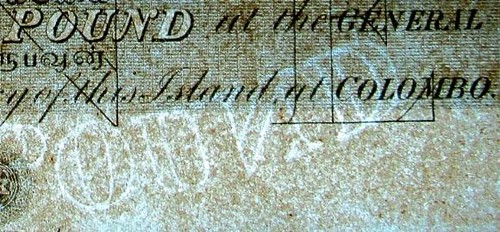
Interesting topic. The full lecture is worth watching; itI's more about using typefaces as an anti-counterfeiting measure. Follow the YouTube link below. -Editor
To watch the video, see:
Tobias Frere-Jones - In Letters We Trust - btconfBER2015
(https://www.youtube.com/watch?v=dfbC_r76V1o)
For more information on the British Ceylon Colombo - Pounds Sterling, see this page from his web site:
British Ceylon Colombo - Pounds Sterling - 1850-1855
(http://notes.lakdiva.org/british/psd/1850_gtgc_sterling.html)
SEATED FEST II BALTIMORE 2019
A great educational event is coming up next week in Baltimore. If you're at the show, this shouldn't be missed. -Editor
Brought to you by the Liberty Seated Collectors Club
? Passionate about Liberty Seated coinage?
? Are you just interested in learning a little more about it?
? Want to see 20 cases of amazing and rare coins?
? Want to see collector-grade coins of all seven Liberty Seated series - half dimes through Trade dollars?
? Want to meet the experts in your favorite series?
? Want to meet collectors of similar interests who are enthusiastic to share their experiences?
Collectors of all experience levels, the Liberty Seated Collectors Club (LSCC) invites you to…
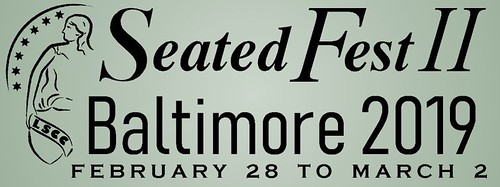
Highlights include:
• Marquee sets of Liberty Seated half dimes, dimes, and quarters
• Collector-grade coins of all series, half dimes through Trade dollars
• The unique 1870-S Half Dime!
• Errors and exonumia
• Four 90-minute educational programs
• and much more!
Open to all - LSCC members and non-members - collectors of all ages, experience, and interests!
In addition, four 90-minute educational sessions over two days are not to be missed, scheduled to allow participants plenty of time to explore the bourse floor. Thursday Feb. 28 and Friday March 1.

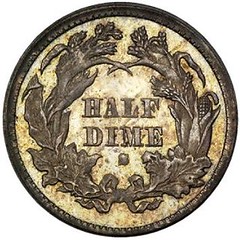
Unique 1870-S Half Dime, will be at Seated Fest!
EDUCATIONAL PROGRAM
Thursday February 28, 9:00 - 10:30 a.m.
Introduction to Liberty Seated coinage, designers, subtypes, Liberty Seated artistry, collecting Liberty Seated coins
Thursday February 28, 3:00 - 4:30 p.m.
Series: Liberty Seated half dimes, dimes, and quarters. Key dates, major varieties, collecting difficulty
Friday March 1, 9:00 - 10:45 a.m.
Series: Double dimes (twenty cent pieces), Trade dollars. Variety attribution, References for Liberty Seated coinage.
Friday March 1, 3:00 - 4:30 p.m.
Series: Liberty Seated half dollars, Liberty Seated dollars. The Andrew Jackson-Sevier Flying Eagle Dollar
Register free for educational program on the LSCC website:
http://www.lsccweb.org/registration.html
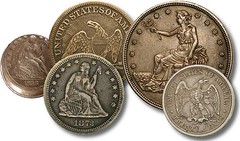
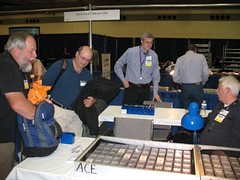
For information about the Whitman Baltimore Spring Expo, see:
http://expo.whitman.com/baltimore-spring-expo/
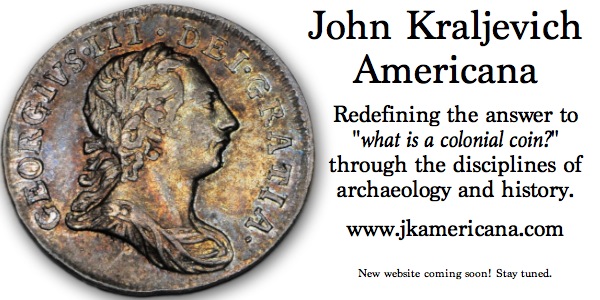
VOCABULARY TERM: CHRONOGRAM
Dick Johnson submitted this entry from his Encyclopedia of Coin and Medal Terminology. Thanks. -Editor
Chronogram. Lettering which contains a date in Roman numerals that are in larger size for emphasis. The letters I, V, X, L, C, D and M are contained in words. The lettering, most often found in the legend, either spell out the date in these Roman numerals, or the numerals add up to the intended date. The date is most charming when it is in typical order of the date in proper number sequence.
Because of the great many legends and inscriptions found on numismatic items, particularly medals, chronograms are an important part of medallic art. It is necessary when cataloging these items to be sure to identify chronograms when they appear. It is somewhat of an internal validation if the date (in Arabic numerals) and the year of the chronogram (in Roman numerals) are equivalent. In other instances the chronogrammatic date is the only one given on the item.
In numismatic catalogs - like on the coins and medals themselves - the lettering should be in small caps, and the chronogram letters in large caps.
Origin of Chronograms. The first known use of a chronogram was in Hebrew in 1208. Arabic chronograms date to as early as 1318. In Germany medallic engravers were employing chronograms extensively in the 1600s. The first use of the term in English was in 1621.
Variations. Since I (for the numeral one) is the only vowel among Roman numerals, it is the easiest to include. Because of its infrequency in words X (for ten) is sometimes difficult. When adding the letters a W has sometimes been used for two Vs (two fives), the equivalent for the numeral ten.
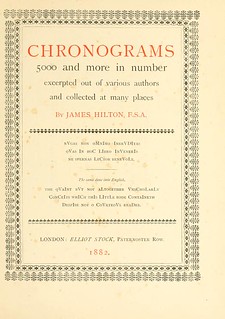 The charm of
finding a chronogram on a numismatic item is one of the appeals of this design feature. It is also found with two chronograms, double chronogram, on
perhaps an anniversary medal where the date of the original event and the anniversary year being commemorated. (The largest collection of chronograms was the
1882 book by James Hilton published in London, Chronograms: 5000 and More in Number Excerpted Out of Various Authors and Collected at Many Places, had a
double chronogram on its title page, with a chronogrammatic subtitle in both Latin and English.)
The charm of
finding a chronogram on a numismatic item is one of the appeals of this design feature. It is also found with two chronograms, double chronogram, on
perhaps an anniversary medal where the date of the original event and the anniversary year being commemorated. (The largest collection of chronograms was the
1882 book by James Hilton published in London, Chronograms: 5000 and More in Number Excerpted Out of Various Authors and Collected at Many Places, had a
double chronogram on its title page, with a chronogrammatic subtitle in both Latin and English.)
Irrespective of these variations, the appearance of a chronogram exhibits the care in choosing the legend and the exact spelling of the lettering. This is the symbolism in the epigraphy that is the equivalent to the use of graphic symbols, like an attribute, in the design.
Reference:
L3 {1882} Hilton, Chronograms.
N19 {1993} Mackay, p 70-71.
I found a copy of the 1882 Chronograms book on the Internet Archive, and added the cover image. Another great source is Chapter VI of Robert TurfboerI's Tempus in Nummis, one of my favorite numismatic books. I've had a harder time locating a nice color image of a coin or medal clearly illustrating a chronogram. Can anyone help? Thanks in advance. -Editor
To read the complete Chronograms book, see:
Chronograms, 5000 and more in number, excerpted out of various authors and collected at
many places; by Hilton, James (https://archive.org/details/chronograms5000m00hilt/page/n5)
Looking for the meaning of a numismatic word, or the description of a term? Try the Newman Numismatic PortalI's Numismatic Dictionary at: https://nnp.wustl.edu/library/dictionary
Or if you would like a printed copy of the complete Encyclopedia, it is available. There are 1,854 terms, on 678 pages, in The Encyclopedia of Coin and Medal Technology. Even running two a week would require more than 19 years to publish them all. If you would like an advance draft of this vital reference work it may be obtained from the author for your check of $50 sent postpaid. Dick Johnson, 139 Thompson Drive, Torrington, CT 06790.
AMOS F. ENO (1836-1915)
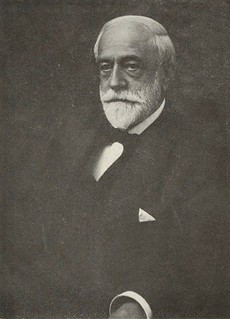 Amos F. Eno
(1836-1915), was born June 13, 1836, son of Amos Richards Eno (1810-1898) and Lucy Jane Phelps Eno (1818-1913).
Amos F. Eno
(1836-1915), was born June 13, 1836, son of Amos Richards Eno (1810-1898) and Lucy Jane Phelps Eno (1818-1913).
The Eno family is a Colonial American family and one of the families that can trace their lineage to Richard Warren on the Mayflower.
Amos F. Eno was a New York tycoon, one of New York CityI's Washington Square millionaires, heir to the family fortune of about $40 Million.
Amos Eno never married and left his estate in its entirety to Columbia University. The will was contested in the probate courts for seven years concluded June 21, 1922.
The coin collection is assumed to have become property of Columbia University.
During the Civil War his uncle John S. Phelps was appointed governor of Kansas, and Amos F. Eno, was his Secretary. These offices were abolished in July 1863.
Correspondence in the Lupia Numismatic Library shows that Eno wrote the Chapman Brothers three times in January 1906, on the 3rd, the 5th and the 26th.
He died October 21, 1915. He is buried in the family Mausoleum, Simsbury Cemetery, Simsbury, Connecticut.
Two bronze childhood portraits of his niece Alice Eno were made into medals by Scudder in 1906 are in the ANS Collection.
To read the complete article, see:
ENO, AMOS F
(https://sites.google.com/a/numismaticmall.com/www/numismaticmall-com/eno-amos-f)
The entire inventory of the Lupia Numismatic Library is for sale. Individual items will be available before the remaining archives are broken up into parcels sold at philatelic auctions in the U. S. and Hong Kong. Check NumismaticMall.com frequently as dozens of new items with estimates will be posted daily until everything is sold.
All inquiries will be given prompt and courteous attention. Write to: john@numismaticmall.com .
HARVEY STACKI's NUMISMATIC FAMILY, PART 38
Harvey StackI's blog series focuses on living in a numismatic family. Here is part 38. Thanks, Harvey. -Editor
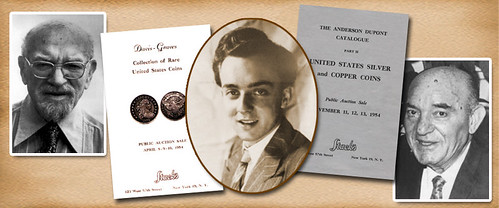
But in 1965 Stack's was excited to be awarded some major collections to sell at public auction. Some of the concerns of the previous year had abated and friends and clients once again looked to sell.
We started 1965 with the sale of the Dr. Moser Lyons Stadium Collection, which featured splendid United States gold, silver and copper coins. Following that sale, we offered a collection of very choice and rare items formed by Eugene Gardner. Eugene had a wonderful eye for quality, and he concentrated on well struck, lightly toned coins, which even today are considered among the finest known.
In spring 1965 we held our auction during the Metropolitan Numismatic Convention. Featured was the Grant Pierce Collection of United States gold, silver and copper coins, including date sets and rare mintmarks. Grant Pierce, a great friend of my father Morton, was the president of American Standard, one of the largest American plumbing supply companies. He was an avid fisherman and hunter, and could be seen in pictures in sporting magazines, as he enjoyed his hobbies so much. The gold coins were highlighted by his collection of $3 gold pieces mostly in glittering Proof. Pedigrees in the Grant Collection could be traced to various B. Max Mehl sales of the 1940s and 1950s (including the Renz Collection and the Atwater Collection) and to a number of Stack's name sales of the same period. We did not offer his sets of Indian Head and Saint-Gaudens coins, as he gave those sets to his grandson who lived in the Midwest.
Later in 1965 we sold the George Sealy Ewalt Collection of both foreign and United States coins, along with the Charles Kenzie Collection and the Henry Kingman Collection.
All in all, everyone in the Stack family and those who worked with us in the shop were kept very busy. Our Coin Galleries branch specializing in foreign and ancient coins was expanding. There was always cataloging to be done, buying and selling over the counter, as well as traveling to shows and to gather consignments. Uncle Norman was a dedicated cataloger and researcher, and he preferred to do his work in the office as opposed to traveling. My father was still active in the office, cataloging, overseeing operations, and dealing with clients. His health was failing, but he still tried to be in the shop whenever we were open. My cousin Ben and I did the majority of the traveling both to conventions and to meet with clients. Of course, all of us at Stack's were focused on building relationships with and working closely with collectors.
One customer we continued to work closely with was J.K. Lilly who was keeping active building his gold coin collection. During 1965 we were fortunate to find a good number of world gold coins to enhance the Lilly Collection. The number of coins he had acquired from 1951 to 1965 was well over 6,000 different gold coins of the world! He enjoyed adding different dates and mints from all periods that gold coins were struck. In early April, I made my customary delivery to him, helped him place the coins in the special coin trays designed for his growing collection. He told me, as he always did, that he was looking forward to stopping by on West 57th Street in the fall, when he was on his way back to Florida for the winter.
To read the complete article, see:
Harvey Stack Remembers: Growing Up in a Numismatic Family, Part 38
(https://www.stacksbowers.com/News/Pages/Blogs.aspx?ArticleID=3290)
To read the earlier E-Sylum article, see:
HARVEY STACKI's NUMISMATIC FAMILY, PART 37
(https://www.coinbooks.org/v22/esylum_v22n06a13.html)
MORE ON JIM KING
Jeff Rock of San Diego submitted these recollections of dealer Jim King. Thanks. -Editor
I was saddened to hear of the passing of Jim King. Jim was truly of the old school. Impeccably dressed (and his wife looking like an ageless fashion model), always courteous, Jim had a keen eye and traveled extensively in Europe. For the better part of 20 years I would always make JimI's one of the first tables I stopped at for any major show - and almost invariably he would have something truly special that lightened my checkbook after I had barely stepped on the bourse floor!
Jim didn't go in much for slabs (though in the last few years he had a few, as we all seem to nowadays - the plastic version of kudzu, you just can't escape). He never cared about having the Finest Known of anything. But he always had an eye for quality - and for the unusual. Jim turned up obscure tokens and medals, rare varieties of French Colonies coins, and brought many colonial coins back home from Europe (who knows how they got there!). Jim really needed to be interested in something to deal in it - and his customers tended to be people who were just as interested in the same things, meaning that whenever he showed us something we were usually reaching for that checkbook before we even asked the price.
Jim had an amazing memory - this was a man who spent over 60 years in coins, and was going to European (and American) auctions before many of us were born. What he saw, he remembered - and he was always happy to share. I remember showing him an extremely rare piece I had bought, and he said he had seen that piece in an auction in the early 1960s and gave me the month and year of the sale. I was going to razz him a bit when I saw him next because he got the year right but he was off on the month - well, at least until I looked closer at the sale dates and realized it started at the end of one month and finished the first day of another and, of course, the coin was in the section that made what he said absolutely correct!
He also used that memory for looking for really special pieces. One example was a Washington colonial coin struck over an exceedingly rare British token -- he saw it at auction four decades previously, and looked at every Washington piece of that type until he found another. That was one of the coins that lightened my checkbook considerably, and the coin now resides in one of the finest Washingtonia collections ever formed - and no other has since been found.
Jim didn't socialize much in the hobby, and the only time I ever remember seeing him go out to dinner with someone from coins was with his old friend Bob Vlack. He didn't put out price lists, and he didn't call or write customers with things for sale. He simply showed up consistently and people knew to get to him quickly. I hadn't seen him at a show in a couple years, and had heard that he was having health issues - but he was going strong into his early 80s I believe (no one would ever presume to ask him his age - and DEFINITELY not that of his wife!) - traveling the world and setting up at shows at a time in life when many people can barely move or remember whether they had breakfast or not.
Jim could easily be summed up in one word -- one that isn't often used in numismatics these days. Class.
Bill Rosenblum writes:
As Paul Bosco and Alan Weinberg mentioned Jim was of the old school and thoroughly knowledgeable about numerous numismatic areas. Ever since I've known him (1970s) he woulds travel across the pond a few times a year to buy from his sources. He would return with lots and lots of goodies. Over the years I purchased hundreds of Operation Bernhard Forgery notes from him especially when it was easier for British dealers to wholesale them to an American dealer rather than to retail them to their local collectors. As I mentioned a few months back the Kings, the Margolises and the Rosenblums made numerous trips to the Carnegie Deli in NYC to bring humongous corned beef and pastrami sandwiches to eat behind our bourse tables when most of the NYC shows were on 7th Ave.
The last time I spoke with Jim was a few weeks after Dick Margolis had passed and we reminisced about past deals and meals. Jim told me that he was down to doing a New Hampshire show a couple of times a year but would go to NY for a Celebration of Life Ceremony organized by Lu Birkler for Dick Margolis and Chris Blom who also passed late last year.
Unfortunately Jim had a nasty fall soon after we spoke and he was basically confined to hospitals and rehab centers after that. Jim and I shared bourse tables and hotel rooms for years. The rooms shared only when we weren't traveling with our wives obviously. We also shared numerous meals and many glasses bottles of beer. Actually we each drank our own beer.
I don't know if Jim was a member of the NBS but I stayed at his homes in both NJ and Cape Cod over the years and his library was immense, containing not only books upon books, but periodicals, auction catalogs and pricelists from all over the world. I believe that before Jim went into numismatics full-time he worked as a union official in the steel industry in Pittsburgh.
Thanks for your note. I didn't come on the Pittsburgh numismatic scene until the 1980s and never encountered Jim King; he may have moved away by then. I don't recall him being mentioned as a local collector or dealer.
David Lisot filmed a video interview with Jim King at the London Coin Fair in November, 2011. Follow the link below to watch it on the CoinWeek site. Jim grew up in Butler, PA, 30 miles north of Pittsburgh. He began collecting in 1946. Working at a local store, he saw Indian Cents, and Buffalo and Liberty Head nickels in change. Periodically he would travel down to Pittsburgh to visit coin dealers. He would sell his circulation finds and buy older coins he enjoyed more. He recalls purchasing Bust half dollars for 65 cents! -Editor

To watch the complete video, see: Numismatic Interview with James D. King (https://coinweek.com/people-in-the-news/numismatic-interview-with-james-d-king/)
To read the earlier E-Sylum article, see:
NOTES FROM E-SYLUM READERS: FEBRUARY 17, 2019 : Jim King
(https://www.coinbooks.org/v22/esylum_v22n07a09.html)

MORE ON JOSH TATUM AND THE NICKEL GYP GAME
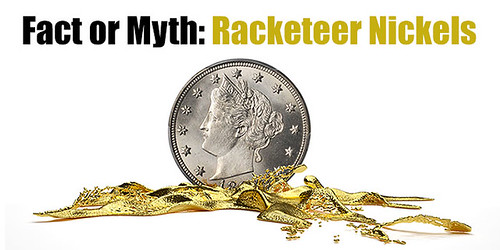
NNP Project Coordinator Len Augsburger writes:
The earliest mention of Josh Tatum found on the Newman Numismatic Portal is in the October, 1958 issue of Numismatic Scrapbook Magazine.
Len provided a copy of the text to Lianna Spurrier and Julia Purdy for their research into the Josh Tatum story. JuliaI's found an earlier version. -Editor
Julia writes:
I found a slightly older mention of Joshua Tatum / Josh Tatum and the 1883 nickels. This is from May 22, 1955 and it attributes the story to Brooklyn/New Jersey numismatist Charles H. Ryan. I believe he is one and the same as Cecil H. Ryan - I'm not sure why he started using a different name. The author of this piece Michael "Mickey" MacDougall "The Card Detective" is quite a character too!
I transcribed the article from the "Camerica" Sunday magazine of the Dayton Daily News. I think it was likely published in multiple newspapers across the country but I only found this one printing.
There are two parts to this newspaper article. The first part describes RyanI's interactions with the U.S. Secret Service over his production of what seem to be repousse "push-out" coins. The second part is RyanI's Joshua Tatum story. -Editor
INSIDE STRAIGHT
THE NICKEL GYP GAME
By Michael MacDougall
Exposer of Cheats, Swindlers
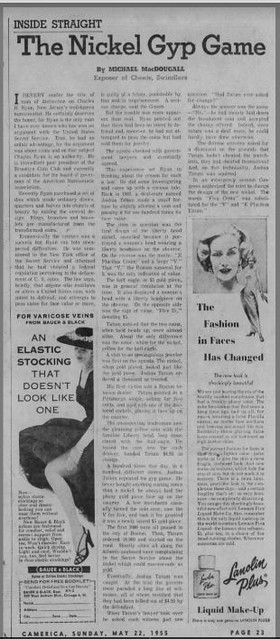 I HEREBY confer the title of man of distinction on Charles H. Ryan, new Jersey's well-known numismatist. He
certainly deserves the honor, for Ryan is the only man I have ever known who has won an argument with the United States Secret Service. True, he had an unfair
advantage, for the argument was about coins and on that subject Charles Ryan is an authority. He is immediate past president of the Brooklyn Coin Club and
currently a candidate for the board of governors of the American Numismatic association.
I HEREBY confer the title of man of distinction on Charles H. Ryan, new Jersey's well-known numismatist. He
certainly deserves the honor, for Ryan is the only man I have ever known who has won an argument with the United States Secret Service. True, he had an unfair
advantage, for the argument was about coins and on that subject Charles Ryan is an authority. He is immediate past president of the Brooklyn Coin Club and
currently a candidate for the board of governors of the American Numismatic association.
Recently Ryan purchased a set of dies which made ordinary dimes, quarters and halves into objects of beauty by raising the central design. Rings, brooches and bracelets are manufactured from the transformed coins.
Economically the venture was a success but Ryan ran into unexpected difficulties. He was summoned to the New York office of the Secret Service and informed that he had violated a federal regulation pertaining to the defacement of U.S. coins. The law says briefly, that anyone who mutilates or alters a United States coin, with intent to defraud, and attempts to pass same for face value or more, is guilty of a felony, punishable by fine and/or imprisonment. A serious charge, said the G-men.
But the trouble was more apparent than real. Ryan pointed out that there had been no intent to defraud and, moreover, he had not attempted to pass the coins but had sold them for jewelry.
The agents checked with government lawyers and eventually agreed.
This experience set Ryan to thinking about the reason for such a law. He did some investigating and came up with a curious tale. Back in 1883, a deaf-mute named Joshua Tatum made a small fortune by slightly altering a coin and passing it for one hundred times its face value.
The item in question was the first design of the liberty head nickel, so-called because it portrayed a woman's head wearing a liberty headpiece on the obverse. On the reverse was the motto: 'E Pluribus Unum" and a large "V." The "V," the Roman numeral for 5 was the only indication of value.
The half eagle, or $5 gold piece, was in general circulation at the time. It also displayed a woman's head with a liberty headpiece on the obverse. On the opposite side was the sign of value, "Five D.," denoting $5.
Tatum, noticed that the two coins, when held heads up were almost alike. About the only difference was the color--white for the nickel, yellow for the half-eagle.
A visit to an unscrupulous jeweler was first on the agenda. The nickel, when gold plated, looked just like the gold piece. Joshua Tatum ordered a thousand so treated.
His first victim was a Boston tobacco dealer. Tatum pointed to a Pittsburgh stogie, selling for five cents, and paid with one of the doctored nickels, placing it face up on the counter.
The unsuspecting tradesman saw the gleaming yellow coin with the familiar Liberty head, long associated with the half-eagle. He tossed the coin into the cash drawer, handed Tatum $4.95 in change.
A hundred times that day, in a hundred different stores, Joshua Tatum repeated the gyp game. He never bought anything costing more than a nickel, he always laid the phony gold piece face up on the counter. A few merchants casually turned the coin over, saw the V for five, and took it for granted it was a newly issued $5 gold piece.
The first 1000 were all passed in the city of Boston. Then, Tatum ordered 10,000 and started on the road. Shortly cities all along the Atlantic seaboard were complaining to the Secret Service about the nickel which could masquerade as gold.
Eventually, Joshua Tatum was caught. At the trial the government paraded a long line of witnesses, all of whom testified that they had been bilked out of $4.95 by the defendant.
When Tatum's lawyer took over he asked each witness just one question. "Had Tatum ever asked for change?"
Always the answer was the same -- "No,"-- he had merely laid down the fraudulent coin and accepted the change offered. Indeed, since Tatum was a deaf mute, he could hardly have done otherwise.
The defense attorney asked for a dismissal on the grounds that Tatum hadn't cheated the merchants, they had cheated themselves! And, on that technicality, Joshua Tatum was acquitted.
In an emergency session Congress authorized the mint to change the design of the new nickel. The words "Five Cents" was substituted for the "V" and "E Pluribus Unum."
Julia adds:
The Scrapbook piece is from 1958 and the C.H. Ryan / MacDougall article is from 1955. The text of the Tatum tale is very similar on both publications. It may have started with Ryan and/or MacDougall -- but I wouldn't be at all surprised if something earlier turns up.
Pete Smith writes:
About twenty years ago I worked for a large international law firm. We employed a records clerk who went to law school and returned to work for us during the summer. I told him the story of Josh Tatum and asked if he could do a check through legal records to confirm the story. He was unable to find any record of a court case involving Tatum. I became more convinced that the Tatum story is a myth.
Emergency session of Congress? I doubt that. As Paul Schultz and others have pointed out, parts of this tale are hard to swallow.
Thanks to Len, Julia and Pete for their sleuthing work. If a court case can't be found the entire story is suspect.
Was this the source for subsequent retellings of the tale in numismatic circles? Time will tell - can any earlier published version be found? See JuliaI's article (next up in this issue) for more information on Cecil "Charles" Ryan.
HereI's a thought: If Ryan was making repousse coins, was he making gold-plated "Racketeer" nickels as well? His newspaper article provides a perfect background story. -Editor
To read the earlier E-Sylum articles, see:
NEW BOOK: POP OUT REPOUSSE COINS, 3RD EDITION
(https://www.coinbooks.org/v20/esylum_v20n01a05.html)
SEEKING (BUT NOT FINDING) JOSH TATUM
(https://www.coinbooks.org/v22/esylum_v22n07a07.html)
BROOKLYN COIN CLUB PRESIDENT CHARLES H. RYAN
Julia Casey writes:
HereI's what Julia has been able to find so far. -Editor
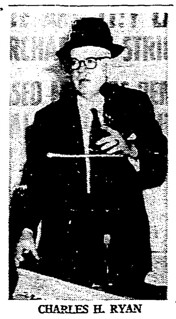 Cecil Howard Ryan, aka
Charles H. Ryan, C.H. Ryan was born about 1901 in Brooklyn, NY, the eldest child of Frank Ryan and Mary Ryan. He is indexed in the census records as Cecil Ryan
through 1940 and apparently did not begin to refer to himself as Charles until sometime in the 1950s.
Cecil Howard Ryan, aka
Charles H. Ryan, C.H. Ryan was born about 1901 in Brooklyn, NY, the eldest child of Frank Ryan and Mary Ryan. He is indexed in the census records as Cecil Ryan
through 1940 and apparently did not begin to refer to himself as Charles until sometime in the 1950s.
Per an article published in The Jersey Journal (Jersey City), November 11, 1960 Charles H. Ryan joined the Railway Express Agency in 1919 and supported his family after his father died. Along with his work for the Railway Express Agency he was a journalist for the Brooklyn Standard, in the "jewelry business" and an inventor in 1955 of a "compact tractor-trailer control board." Since about 1940 Ryan was an auctioneer for the express company's "lost and damaged" shipments.
The article also notes that "He is a member of the board of governors of the 30,000-member American Numismatic Association and a past president of the Brooklyn Hammond Organ Society."
In the Boston Herald Sunday, Aug 22, 1948 there is a photograph entitled "Gold Coins and Medals Worth $50,000 are displayed by Mrs. Opal Morris of Homewood, Ala. at Copley Plaza exhibit of the American Numismatic Association. Collection shown is owned by Cecil H. Ryan of Brooklyn, N.Y., president of the Brooklyn Coin Club."
There is a Cecil Howard Ryan listed in "THE ROYAL NUMISMATIC SOCIETY: PATRON HIS MAJESTY THE KING: LIST OF FELLOWS" June 1948. His address is "5 Beechwood Drive, Glenhead, Long Island, N.Y. U.S.A.
A snippet from The Numismatist found on the Newman Portal makes reference to C.H. Ryan's Glenhead residence. From December 1947, p 117:
The meeting was then adjourned to the palatial residence of our host C H Ryan in nearby Glen head. Mrs Ryan was on hand to bid us welcome and put us at ease. The entire house was at our disposal and refreshments and food were served of the most tempting varieties. The sincere thanks of the entire membership of our club goes to our gracious host and his charming wife for having made this meeting a most enjoyable one not likely to be forgotten for a long time.
Also in the September, 1949 edition there is a reference to the death of his wife Mary on p. 12:
OBITUARY MARY MAHONEY RYAN. Mary Mahoney Ryan beloved wife of Cecil Howard Ryan President of the Brooklyn Coin Club passed away July 8 1949 at Fifth Avenue Flower Hospital after two years illness of cancer. Born in the old Fourth Ward of New York City she had resided in the New York area for most of her lifetime and also at Glen head, Long Island. Many were her friends among New York and Brooklyn numismatists and a large representation attended funeral mass of requiem at St Charles Borromeo R C Church at Sidney Place and Livingston Street Brooklyn New York. The only survivors are her husband Cecil Howard Ryan sales agent for the Railway Express Agency and her brother James J Mahoney of the U S Customs Service...
A June 30, 1966 article in the Jersey Journal "Charles Ryan Retires: Auctioneer Can Appraise Valued 25-Year Career" notes that:
"Though Ryan will be in retirement from the REA, he will still be on call for Francis Cardinal Spellman in evaluating for insurance purposes the prelate's $500,000 collection of world coins. With another expert, Louis Werner, Ryan will also continue to appraise the Cardinal's $750,000 worth of stamps."
Per "American Numismatic Biographies" by Pete Smith (2012) the entry for Cecil Howard Ryan is as follows: ANA Board (b. 1/18/1886 d. 8/3/1970). Married to Pauline Simmons with two children. In 1948 he received the ANA Medal of Merit. Served on the ANA board 1955 to 1956.
I believe this biographical information is for the wrong Cecil Howard Ryan as that Cecil Howard Ryan lived all his life in Mississippi. His obituary from the Jackson, Mississippi Clarion-Ledger on August 6, 1970 does not make any reference an interest in numismatics.
Pete Smith writes:
I agree with Julia that the listing in American Numismatic Biographies for Cecil Howard Ryan is incorrect. I tried for more than an hour to find his correct dates of birth and death without success. I did see that he was age 49 in 1950 so his date of birth was close to 1901.
I don't believe that Ryan changed his name. Cecil Howard Ryan was his legal name. Within the casual atmosphere of the Brooklyn Coin Club, he was called Charlie. Someone who knew him as Charlie Ryan may have written his name as Charles Ryan. The names C. H. Ryan, Cecil H. Ryan, Charlie Ryan, and Charles H. Ryan appear to have been used concurrently in the 1950I's.
THE MUSEUM OF AMERICAN FINANCE IS MOVING
The Winter 2019 issue of Financial History contains an announcement from President and CEO David J. Cowen. The Museum of American Finance has terminated its lease in lower Manhattan and is looking for a new home for MoAF. -Editor
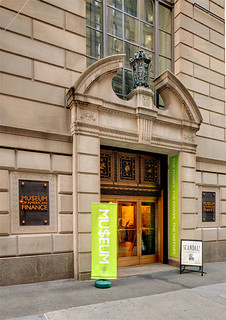 What does the future hold for our Museum? Recall our core purpose is to preserve, exhibit and teach about our
nation's finances and financial history. So we need to preserve our amazing and unique collection of tens of thousands of artifacts that span the history
of American finance and include many of our nation's founding financial documents.
What does the future hold for our Museum? Recall our core purpose is to preserve, exhibit and teach about our
nation's finances and financial history. So we need to preserve our amazing and unique collection of tens of thousands of artifacts that span the history
of American finance and include many of our nation's founding financial documents.
We've survived two floods in Downtown New York City: one from the outside from Super Storm Sandy, and one from the inside from the building. They say things happen in threes, and we're not going to stick around to find out. Therefore, this year we will be raising the funds to move our collection to a state-of-the-art archival facility that will not only safeguard and catalog, but will fully digitize all of our documents. Once our collection is digitized, that will help us to create online exhibits that will allow us to expand our reach exponentially.
Second is to continue and expand our financial literacy programs. We have the props of history. What differentiates us is that when we teach financial literacy and teach stocks and bonds, we actually have the certificates to show the students. In many cases, we give them one (of course matured) as a takeaway when they finish the class. In 2019 we look to greatly expand our outreach into the New York City school system.
 As far as exhibit space, we're at a critical juncture in the Museum's history, as we create a state-of-the-art
finance museum. We don't want to have museum 2.0; we want museum 10.0. We are investigating several properties here in Downtown and other parts of New York
for our permanent home. Tonight is a great step forward; with all of your generosity, we have raised over $1 million. I want to thank you from the bottom of my
heart. That is the first step.
As far as exhibit space, we're at a critical juncture in the Museum's history, as we create a state-of-the-art
finance museum. We don't want to have museum 2.0; we want museum 10.0. We are investigating several properties here in Downtown and other parts of New York
for our permanent home. Tonight is a great step forward; with all of your generosity, we have raised over $1 million. I want to thank you from the bottom of my
heart. That is the first step.
Therefore, in 2019 we're on the cusp of creating a museum for the next generation. If we are to move this museum into the future, to best represent our industry and help millions of Americans develop much-needed financial self-sufficiency, then we need you, our strongest supporters, to help propel us forward. I look forward to working with you to change these dreams into reality.
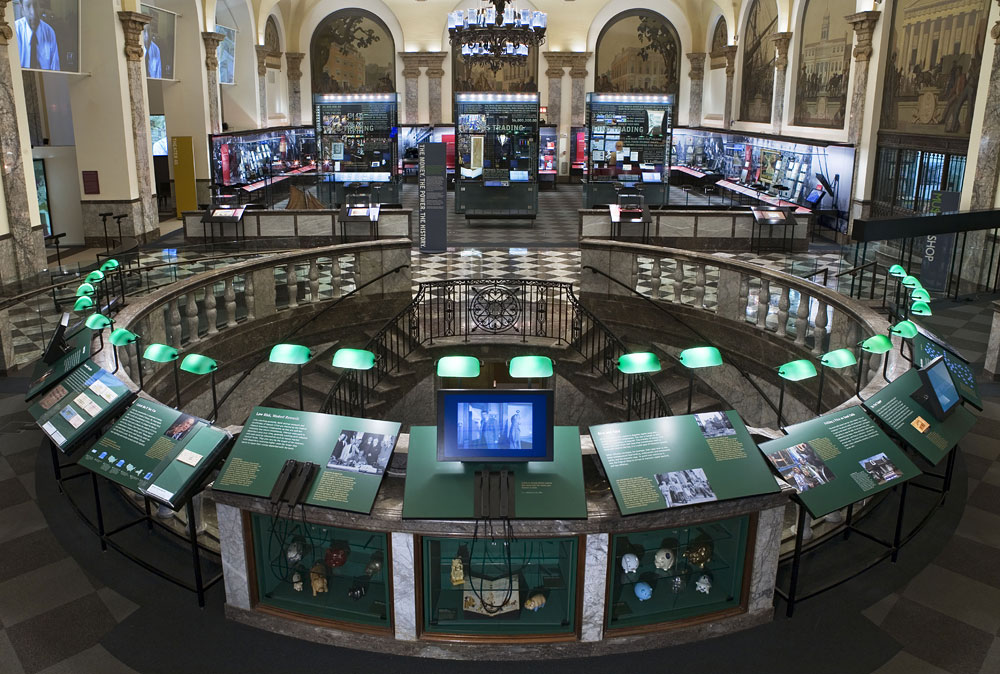
MoAF already provides digital issues of Financial History to the Newman Numismatic Portal for sharing with the numismatic community and the world; the digitization of their great collection will make much more information available to the research and collecting communities.
In another article Museum Deputy Director Kristin Aguilera added these notes about current and future MoAF programs. -Editor
The Museum of American Finance announced in December that it terminated its lease at 48 Wall Street in New York City. It had been located in the historic bank building since 2008, and its lease was scheduled to expire in 2021.
The lease termination was prompted by a major flood that occurred on January 14, 2018, when a main water pipe burst in the building. Although all three floors of the Museum sustained significant water damage, none of the objects on display or in the archives were damaged in any way. The Museum's world-class collection of financial documents and artifacts, many dating from the 18th century, was immediately relocated to a climate controlled art storage facility, where it remains safe.
Despite the Museum gallery being closed in 2018 due to the flood, nearly all of its programs proceeded as scheduled at off-site facilities. This included more than a dozen public programs in its Lunch & Learn and Evening Lecture Series, as well as a traveling exhibit in Washington, DC, showcasing treasures from the Museum's collection. The Museum also continued to offer guided walking tours of the Financial District and proceeded with key components of its educational programming, including the Museum Finance Academy (MFA)-its free eight-week personal finance program for high school juniors and seniors. Although the exhibit galleries will remain closed during the relocation, all of the Museum's other programs will continue off site. In addition, new education programs will be added in 2019, bringing MoAF educators into New York City area schools.
According to Museum President/CEO David Cowen, "We were looking to relocate the Museum in a few years given that our lease was expiring, so this was a natural time to discuss moving up the timetable."
The early termination of the lease enables the Museum to explore new venue and partnership opportunities, and to re-build all of the exhibitions from the ground up.
"Our opportunities are now openended, as we reimagine what a state-of-the- art finance museum could be," said Cowen. "I look forward to working with our board, staff and supporters as we script this exciting future for the nation's only independent finance museum."
Good luck to the MoAF as they take this next step into the future. -Editor
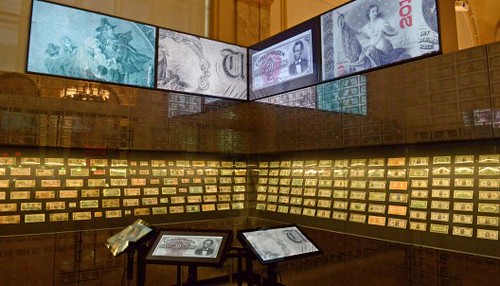
The Mark R. Shenkman exhibit of U.S. Currency at MoAF
For more information on the Museum of American Finance, see:
https://www.moaf.org/
To read earlier E-Sylum articles, see:
JOHN E. HERZOG: FRIEND OF FINANCIAL HISTORY
(https://www.coinbooks.org/v21/esylum_v21n32a18.html)
THE MUSEUM OF AMERICAN FINANCE (https://www.coinbooks.org/esylum_v17n40a19.html)
COUNTERFEIT 1893-S DOLLAR IN A FAKE PCGS HOLDER

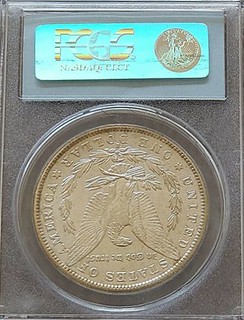
Bill Groom writes:
The Coin Community Forum is a website thatI's much valued by collectors and dealers alike. This past week an astute CCF member spotted a counterfeit 1893-S Morgan $1 in an apparently counterfeit PCGS slab that was posted for sale on eBay. An online discussion of the item ensued, and multiple reports were filed. Bids exceeded $2,000 before the item was pulled by eBay.
Sadly, many fake numismatic items continue to be sold on this venue. One way that buyers can exercise due diligence in their online purchases is to participate in a forum like the CCF or CoinTalk. These forums are FREE!
Anyone wishing to to view the discussion can visit the CCF at the link below.
Thanks. Anything people make, other people can fake. Be careful out there in the marketplace! -Editor
To read the complete discussion thread, see:
Is This A Counterfeit 1893-S Morgan In A Fake PCGS Holder?
(https://www.coincommunity.com/forum/topic.asp?TOPIC_ID=340043)
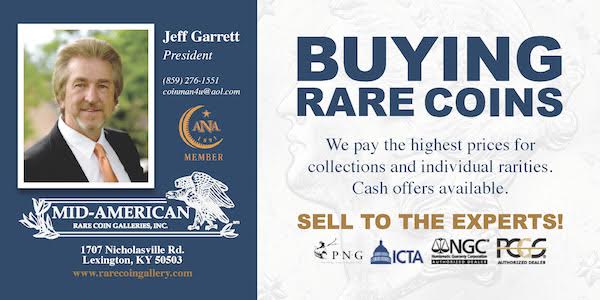
BLOOD-STAINED CURRENCY
Another forum discussion over on Coin Talk caught my eye this week - blood-stained currency. -Editor
John Kent writes:
Hey there! Just a quick note to see if there are any currency collectors that have blood stained currency in their collection? I'm looking for some good examples with or without the back story, that I can bring into public schools to try and get kids interested in numismatics.
Last month, I was doing a presentation to some 7th graders using Japanese invasion currency and one of the students noticed a stain on the currency and thought it was cool, since we were also talking about atrocities that were committed in the Philippines during WW2. The blood stained currency made quite an impression, and the students actually felt connected to WW2 in a new way!
Putting tangible evidence into the students hands helps them connect to the people that used the currency, and thatI's inspiring me to find more and better examples. I've also brought in short snorter bills and concentration camp currency, and I welcome other ideas that put history into students hands and connects them with former generations, and inspires students to learn more!
John adds writes:
HereI's a photo of the stained confederate note I bought today ...
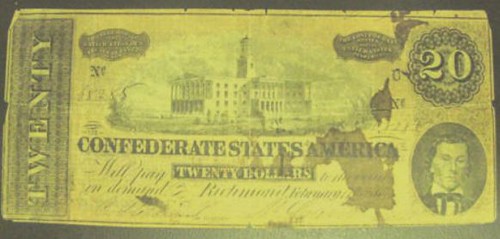
Another participant added writes:
I have collected military currency for almost thirty years. I have seen lots of notes with stains, even red stains. I have always been suspicious of claims of blood stained currency as there is no way to prove a stain was caused by blood versus some other source without chemical analysis.
A little macabre perhaps, but an interesting way to put damaged and otherwise nearly worthless notes to use. Have any such blood-stained notes ever been authenticated and slabbed? The "D.B. Cooper" airplane hijack ransom notes have been slabbed in horrible condition. As numismatic cataloguers learned long ago, a good backstory sells. -Editor
To read the complete discussion thread, see:
Blood stained currency (Cited from:
https://www.cointalk.com/threads/blood-stained-currency.333137/) (https://www.cointalk.com/threads/blood-stained-currency.333137/)
THE GREAT AMERICAN COIN HUNT
In a more traditional numismatic hobby promotion vein is the "Great American Coin Hunt" planned for this April. HereI's an excerpt from a February 19, 2019 Coin Update article. -Editor

Two months from now, in late April 2019, the Great American Coin Hunt is planned to launch as part of National Coin Week. Initially, the Great American Coin Hunt started as an idea formed between several coin dealers, but has since evolved into a viral, grassroots campaign that has taken off in the online numismatic community with tens of thousands of enthusiasts planning to participate in the phenomenon. The plan urges hundreds of coin dealers and collectors to drop over one million vintage and collectible coins back into circulation in the United States in an effort to generate renewed interest into the hobby to demographics that have previously been untapped. Coins and notes planned to be released include Buffalo nickels, Ike dollars, Wheat cents, Silver Certificates, five and 10-dollar blue and red seals - and more. These desirable numismatic treasures will be gracing venues ranging from grocery stores to restaurants from April 21, 2019, to April 27, 2019.
While this idea is not considered completely novel, as it has already been discussed for decades among collectors and dealers who have already implemented similar programs on the local level, the scale of the drop in the Great American Coin Hunt is on a whole different level. It is being called "the biggest coin drop in American history." Managers at banks, restaurants, gas stations, and grocery stores will be crucial in the plan to distribute the coins effectively, but everyday participants are also encouraged to distribute coins into high-traffic areas like malls and airports and to eschew using digital forms of payment for the entirety of the event week. Organizers also plan to release an undisclosed amount of specially marked coins which can be redeemed for genuine numismatic rarities at participating coin shops across the United States. Companies participating in the Great American Coin Hunt will be displayed on the event's website, with companies pledging more coins getting a more prominent spot on the site's listings.
Organizers explain that to avoid the chance of losing a key or semi-key date coin forever, they will be distributing a limited amount of vintage coins with hologram stickers on them. Treasure hunters will be able to take these coins to their local participating RAD dealer, which will be listed on the website of the Great American Coin Hunt. That dealer can trade that stickered coin for a true rare coin with a listed Red Book value of up to $100. The dealer would have the choice and would cover the cost of the giveaway.
To read the complete article, see:
Numismatics goes viral in the United
States: The coming Great American Coin Hunt
(http://news.coinupdate.com/numismatics-goes-viral-in-the-united-states-the-coming-great-american-coin-hunt/)
For more information, the Great American Coin Hunt web site:
https://www.greatamericancoinhunt.com/
AUSTRALIA'S DOLLAR DISCOVERY CONTEST
Australia has its own coin hunt already underway. As noted last November, the Royal Australian Mint is operating a "golden ticket" style campaign to raise awareness of collecting. Canadian Coin News published a short piece about it on February 15, 2019. HereI's an excerpt. -Editor
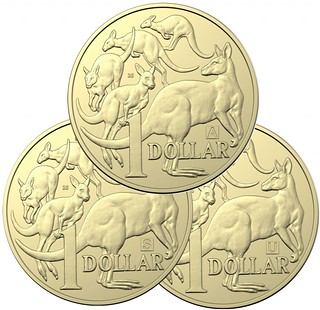 Now in its fourth month, "Australia's Dollar Discovery" is the first-ever national coin hunt in the
"Land Down Under."
Now in its fourth month, "Australia's Dollar Discovery" is the first-ever national coin hunt in the
"Land Down Under."
As an introduction to numismatics, the competition launched last November and encourages people to find some of the three million $1 coins marked with the letters A, U and S and released into circulation last year. Everyone who finds all three marked examples will be entered in the draw for the "major prize," according to the competition website.
"At a time of growing intangibility, the Royal Australian Mint is delighted to launch a program to encourage a whole new generation of collectors both young and old, who will not only collect these coins but also be reminded of the value of a dollar," said CEO Ross MacDiarmid.
The competition closes on April 8, and the winners will be drawn on April 30. There will be eight major prize winners - one for each Australian state and territory - and 250 minor prize winners.
Winners will be announced on May 14, which is the 35th anniversary of Australia's $1 coin.
To read the complete article, see:
Australian mint launches 'golden
ticket' competition in nation's first ever coin hunt
(https://canadiancoinnews.com/australian-mint-launches-golden-ticket-competition-in-nations-first-ever-coin-hunt/)
To read the earlier E-Sylum article, see:
ROYAL AUSTRALIAN MINT LAUNCHES TREASURE HUNT
(https://www.coinbooks.org/v21/esylum_v21n44a22.html)

MEDAL SELECTIONS FROM HEDLEY BETTS
Hedley Betts is a specialist in historical and art medals. He has recently added significantly to his website medalsoftheworld.com .
Highlights include medals from Dassier's series of the Kings and Queens of England, a new section of "Betts," medals commemorating events related to American colonial history; a fine group of Art Deco medals by Perre Turin, a selection of architectural medals by Jacques Wiener, and others by noted medalists. In addition to medals, Hedley carries an unparalleled selection of books on medals. -Editor
Jean Dassier of Geneva published a series of 34 medals of the Kings and Queens of England in 1731. They were offered for sale in England at 6 guineas in bronze and 15 guineas in silver. They were also available in damascened bronze with the fields of the medals bronzed and the relief gilded. The dies for the series came into the possession of Sir Edward Thomason, who reissued the medals around 1820. The earlier medals were struck on slightly thinner flans with slightly beveled edges. They have a finish that is a little duller. The later issues have slightly more reflective surfaces and vary in the color of their patination. Some show signs of die wear and defects. Examples cast from struck medals also exist. They are slightly smaller in size and poorer in quality.
EDWARD I, MEMORIAL - DassierI's medal

EDWARD I, 1272-1307. By Jean Dassier. Bronze 41mm. Obv: Buat of Edward I, in armor, mantle and a crown, facing three-quarters left. Legend: EDOUARD . I . D . G. ANG . ET .HIB . REX. (Edward I, by the grace of God, king of England and Ireland). Rev: A circular temple with three niches containing statues of Minerva (for EdwardI's Wisdom and military genius), Prudence and Hercules (an allusion to the magnitude and variety of EdwardI's enterprizes). At one side History is recording EdwardI's deeds while two onlookers admire the monument on the other side. Exergue: NAT. 1230 . COR. 1272. MORT. 1307. (Born 1230, crowned 1272, died 1307). From ThomasonI's reissue, circa 1820. MI I 5/2, Eimer 10, Eisler I 256/11. DassierI's medal. $100
To read the complete item description, see:
1307, England. EDWARD I, MEMORIAL - DassierI's medal
(https://www.mcssl.com/store/8596432/catalog/product/
f0ccaa27de73464a8b158d60136b8a25)
"Betts" Medals Medals listed in "American Colonial History Illustrated By Contemporary Medals. By Charles Wyllys Betts
1670 British Colonization Medal
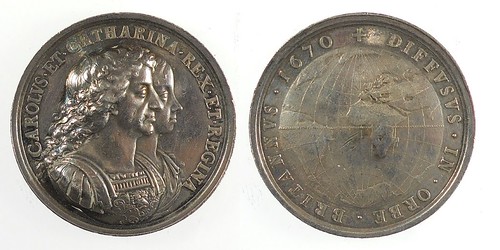
1670, England. BRITISH COLONIZATION. By Jan Roettier. Silver 42mm. Obv: Conjoined busts of Charles II and Catherine facing right. Rev: A globe. Betts 44. MI I 546/203, pl. LV/9. $900
Wow - great medal. -Editor
To read the complete item description, see:
1670, England. BRITISH COLONIZATION. Betts 44
(https://www.mcssl.com/store/8596432/1670-england-british-colonization-betts-44)
1911 Albert Agricultural Students Association Essay Competition Medal
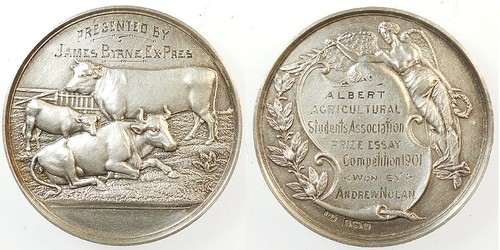
1911, Great Britain. ALBERT AGRICULTURAL STUDENTS ASSOCIATION ESSAY COMPETITION. Silver 46mm. $100
To read the complete item description, see:
Agriculture: ALBERT AGRICULTURAL STUDENTS
ASSOCIATION ESSAY COMPETITION. (https://www.mcssl.com/store/8596432/agriculture-albert-agricultural
-students-association-essay-competition)
For more medal offerings, see: medalsoftheworld.com .
NUMISMATIC NUGGETS: FEBRUARY 24, 2019
HereI's a selection of interesting or unusual items I came across in the marketplace this week. Tell us what you think of some of these. -Editor
Imitation of Philip II of Macedon Tetradrachm
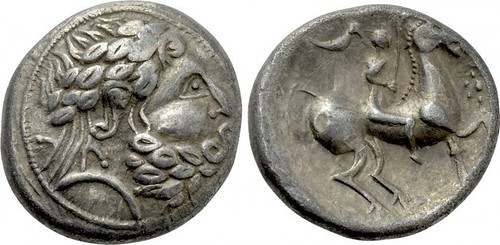
EASTERN EUROPE. Imitations of Philip II of Macedon (2nd-1st centuries BC). Tetradrachm. "Audoleon/Vogelreiter" type.
Obv: Stylized laureate head of Zeus right.
Rev: Stylized rider, with eagle-tipped staff, on horse prancing right.
Lanz 673; OTA 336/2.
Condition: Good very fine.
Weight: 14.27 g.
Diameter: 26 mm.
From the March 2019 Numismatik Naumann sale. Celtic coins have an odd Picasso-like quality. Zeus looks like heI's blowing bubbles, and thatI's an oddly-proportioned horse and rider. Interesting coin. -Editor
To read the complete lot description, see:
EASTERN EUROPE. Imitations of Philip II of Macedon (2nd-1st centuries BC). Tetradrachm.
"Audoleon/Vogelreiter" type. (https://emax.bid/en/lot/391594)
Kumaragupta Elephant Rider Stater
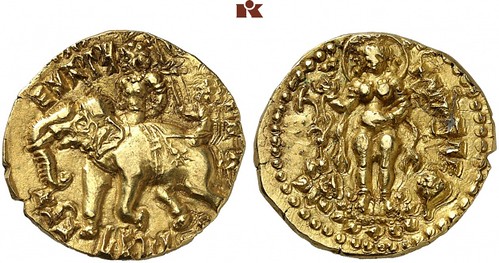
Kumaragupta, 414-455. Ô-Stater, Elephant Rider-Typ; 8.15 g. König reitet l. auf einem Elephanten, von einer kleinen Gestalt mit einem Sonnenschirm geschützt//Lakshmi steht v. v. mit Lotus. Kumar Variante B.
From upcoming the Künker Auction 318. -Editor
To read the complete lot description, see:
Kumaragupta, 414-455. Ô-Stater, Elephant Rider-Typ; 8.15 g. Kumar...
(https://www.kuenker.de/en/auktionen/stueck/212063)
1864 $100 Interest Bearing Note
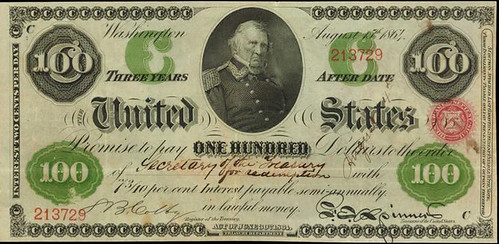
Friedberg 212a (W-3280). 1864 $100 Interest Bearing Note. PCGS Currency Very Fine 30.
This impressive $100 Interest Bearing Note is one of just four examples known for the catalog number. It bears an engraved issue date of August 15, 1864 and displays Lieutenant General Winfield Scott at the center of the note. Black die counters with 100 overlapping Roman numeral Cs are at upper left and right. Green Roman numeral Cs are at upper right and left of center and green 100 die counters are to the bottom left and right. A small red spiked Treasury Seal is to the right. The engraved signatures of Colby and Spinner are seen at bottom left and right respectively. These notes bore 7.3% interest and were payable semi-annually in "lawful money." Buyers were banks and other investors. These notes never passed hand to hand in general circulation. This particular example has the "promise to pay" filled in with "Secretary of the Treasury for redemption."
The back is printed in green with large Roman numeral C counters at left and right. Language on the back, right of center, explains that the notes could be converted to bonds any time after five years, payable 20 years from August 15, 1867 with six percent interest per annum. This example is bright and evenly circulated with ample margins. The printed inks are bold with vibrant green protector inks as well.
All four examples of the catalog number are privately held. This note, with serial number 213729, is the finest graded example of the four. It is the plate note seen on page 629 of the Whitman Encyclopedia of U.S. Paper Money by Q. David Bowers.
From the StackI's Bowers March 2019 Baltimore sale of The Joel R. Anderson Collection of United States Paper Money Part IV. -Editor
To read the complete lot description, see:
Friedberg 212a (W-3280). 1864 $100 Interest Bearing Note.
(https://auctions.stacksbowers.com/lots/view/3-GPF5T)
Compugrade Medals


Three silver-dollar sized anodized aluminum Compugrade medals issued at the 1990 ANA. Scarce. $50 each
From the Sample Slab Update #30 (February 2019) published by David Schwager. -Editor
To read past issues of Sample Slab Update , see:
SampleSlabBook.com (SampleSlabBook.com)
To read an earlier E-Sylum article (also based on Sample Slab Update content, see:
THE COMPUGRADE MEDAL (https://www.coinbooks.org/v20/esylum_v20n15a28.html)
1999 Brookgreen Gardens Medal
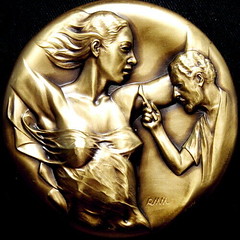
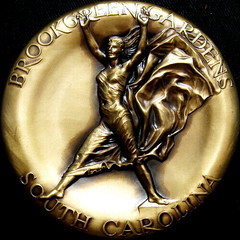
From the eBay stock of dealer Steve Hayden. -Editor
To read the complete lot description, see:
1999 Brookgreen Gardens 76mm
Bronze Members Medal by Richard McDermott Miller
(https://www.ebay.com/itm/1999-Brookgreen-Gardens-76mm-Bronze-Members-Medal-by-Richard-McDermott-Miller/223400576937
HOLABIRD MARCH 2019 WIGWAM SALE SELECTIONS
HereI's are some numismatic lots that caught my eye in next monthI's Holabird Wigwam sale. -Editor
J. L. Polhemus Stamped Two Reales

Wow! 1778 Spanish two reales with counterstamp on obverse and J.L. Polhemus, druggist, 190 J Street, Sacramento. The coin is Km 412.2 Salvatore Falcone Collection.
Date:
City/County: Sacramento
State: California
This famous counterstamp is often encountered on U.S. coins, but less so on foreign coins. -Editor
To read the complete lot description, see:
J. L. Polhemus Stamped Two Reales (90371)
(https://holabirdamericana.liveauctiongroup.com/J-L-Polhemus-Stamped-Two-Reales-90371_i32591037)
Card Room Token Dies
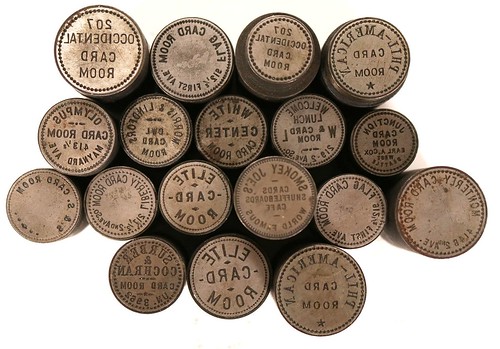
This is a collection of eighteen token dies with diameters from 17 to 25mm, all having the words CARD ROOM on them.
There are quite a number of token die lots in this sale. Check out the catalog online. -Editor
To read the complete lot description, see:
Card Room Token Die Collection
(https://holabirdamericana.liveauctiongroup.com/Card-Room-Token-Die-Collection-100087_i32591086)
Pan Pacific Exposition Medal of Award
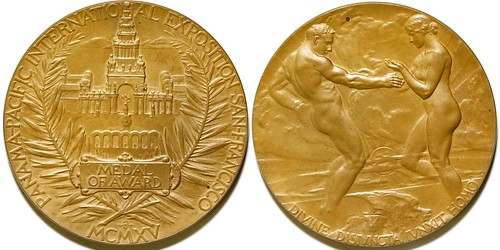
Bronze, 71 mm. "Divine Disivncta Ivnxit Homo" under male and female figures. Rev.: Panama Pacific International Exposition San Francisco / Medal / Of Award / MCMXV.
Date: 1915
City/County: San Francisco
State: California
Nice medal. -Editor
To read the complete lot description, see:
Pan Pacific Exposition Medal of Award
(91130) (https://holabirdamericana.liveauctiongroup.com/Pan-Pacific-Exposition-Medal-of-Award-91130_i32591135)
Hudson/Fulton Celebration Medal

White medal, 31 mm.
Date: 1909
City/County:
State: New York
To read the complete lot description, see:
Hudson/Fulton Celebration Medal (91134)
(https://holabirdamericana.liveauctiongroup.com/Hudson-Fulton-Celebration-Medal-91134_i32591148)
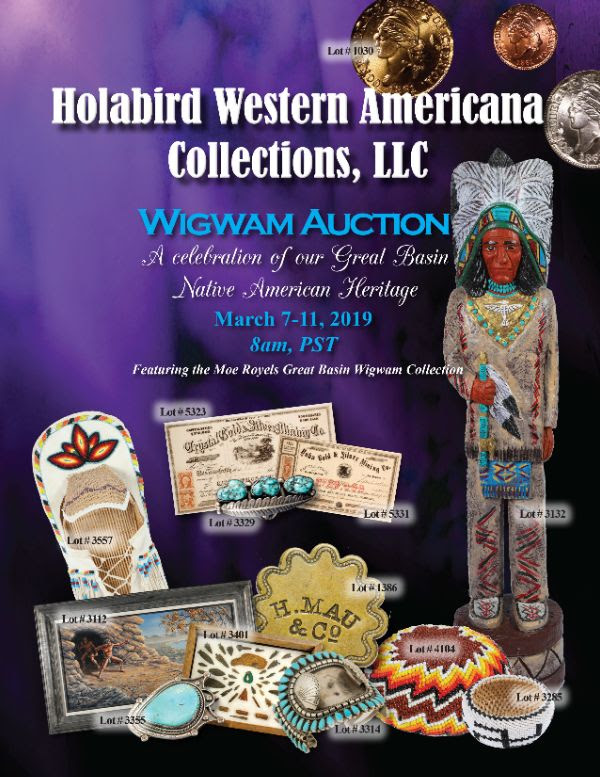
ARCHIVES INTERNATIONAL SALE 51
Here is the press release for the March 19, 2019 sale by Archives International Auctions. -Editor
U.S., CHINESE, MIDDLE EAST & WORLDWIDE BANKNOTES AND SCRIPOPHILY WILL BE OFFERED IN 3 SESSIONS AT PUBLIC AUCTION ON TUESDAY, MARCH 19th, 2019.
The auction will be held by Archives International Auctions at their new offices in River Edge, N.J.
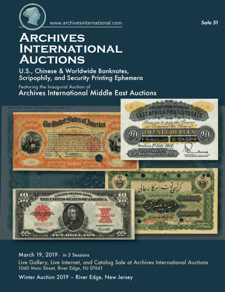 The March 19th auction consists of three sessions beginning with 311 lots of Chinese and Worldwide
Banknotes, Coins and Chinese Scripophily. The second session features over 240 lots of Islamic banknotes in the premier banknote offering from Archives
International Middle East Auctions, a new division of Archives International Auctions. The third session features U.S. Banknotes, U.S. & World Scripophily,
Autographs & Security Printing Ephemera in over 330 lots.
The March 19th auction consists of three sessions beginning with 311 lots of Chinese and Worldwide
Banknotes, Coins and Chinese Scripophily. The second session features over 240 lots of Islamic banknotes in the premier banknote offering from Archives
International Middle East Auctions, a new division of Archives International Auctions. The third session features U.S. Banknotes, U.S. & World Scripophily,
Autographs & Security Printing Ephemera in over 330 lots.
"We are excited to introduce our new division of our company, Archives International Middle East Auctions, which will specialize in Islamic banknotes, coins, medals and related numismatic collectibles", stated Dr. Robert Schwartz, president of Archives International Auctions. "Our current 51st auction will offer over 890 lots of rare and desirable U.S. & Worldwide Banknotes, Coins, and Scripophily with many rare and desirable banknotes seldom offered at auction including items for the beginner to the advanced collector".
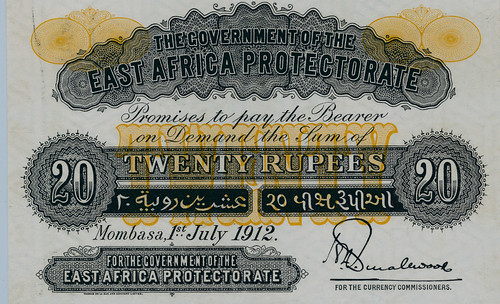
Included in the sale are consignments from numerous estates and longtime collections with many items having never been offered previously at auction. A few of the many World highlights include Lot 202, a 1912, Government of the East Africa Protectorate , Color Trial Specimen rarity; Lot 269, Banco Espanol De Puerto Rico, ND (1894) Specimen Banknote Rarity; Lot 342, India - Princely States / Hyderabad, FE 1333 (1922), 10 Rupees Color Trial Specimen ; Lot 385, a Government of Iraq. L.1931 (1934), 1 Dinar, King Ghazi rarity; Lot 399, a Jordan Currency Board. L.1949 (1952). Specimen 10 Dinars Banknote; Lot 456, a Sultanate of Muscat & Oman, ND (1970), First Issue Specimen Set of 6 Notes; and hundreds of other amazing Worldwide and Islamic banknotes.

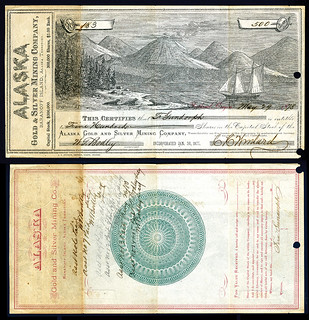 U.S. banknotes and Federal Bonds are
highlighted by Lot 574, a Bank of
Jersey City, 18xx (ca.1850's) $20 Proof Obsolete Banknote rarity; Lot 585, U.S. Legal
Tender, Fr. 123 $10 Series of 1923, PMG CU 64 EPQ; Lot 589, Santa Ana, CA. The Farmers and Merchants National Bank of Santa Ana, $20, 1902 DB Ch#7980 P,
California National Banknote rarity; Two amazing and extremely rare Federal bonds, Lot 611,
U.S. of America. Act of June 13, 1898, 3% Percent Loan of 1898. $5000 3% Registered Bond; and Lot 612, Consol of 1867, $10,000 6% Registered Consol of
1867; Over 20 Obsolete and Vignette printing plates will also be included as well as dozens of other outstanding notes and rarities. The auction ends with over
250 lots of U.S. and World Scripophily highlighted by Lot 777, an Alaska Gold & Silver
Mining Company, 1878 Stock Certificate Rarity and possibly one of the earliest Alaska related stock certificates known;
U.S. banknotes and Federal Bonds are
highlighted by Lot 574, a Bank of
Jersey City, 18xx (ca.1850's) $20 Proof Obsolete Banknote rarity; Lot 585, U.S. Legal
Tender, Fr. 123 $10 Series of 1923, PMG CU 64 EPQ; Lot 589, Santa Ana, CA. The Farmers and Merchants National Bank of Santa Ana, $20, 1902 DB Ch#7980 P,
California National Banknote rarity; Two amazing and extremely rare Federal bonds, Lot 611,
U.S. of America. Act of June 13, 1898, 3% Percent Loan of 1898. $5000 3% Registered Bond; and Lot 612, Consol of 1867, $10,000 6% Registered Consol of
1867; Over 20 Obsolete and Vignette printing plates will also be included as well as dozens of other outstanding notes and rarities. The auction ends with over
250 lots of U.S. and World Scripophily highlighted by Lot 777, an Alaska Gold & Silver
Mining Company, 1878 Stock Certificate Rarity and possibly one of the earliest Alaska related stock certificates known;
Lot 778, The Gold Mining Company, 1888 Issued Stock Certificate, an amazing and classic early Arizona stock certificate; and hundreds of outstanding Bonds and Shares including dozens of topics including railroads, mining, technology, banking, automobile, autographed certificates and dozens of other topics.
Previews will be held at Archives International Auctions offices beginning Wednesday, March 13 th to Friday, March 15 th and Monday March 18 th between 10 AM and 5 PM and by appointment. For an appointment call 201-944-4800 or email info@archivesinternational.com .
The online catalog for the March 19 th sale is on Archives International Auctions' website and can be viewed via the Archives International live bidding platform. It can also be viewed as a virtual catalog or downloadable .pdf on their website. To pre-register for live internet bidding, log on to the Archives International Auctions website, at www.ArchivesInternational.com .
Archives International is now working on their Spring and Summer 2019 auctions and are seeking quality consignments for future auctions or outright purchase including U.S. and worldwide banknotes, coins, stocks, bonds, stamps, postal history, historic ephemera, and autographs. To sell or consign one piece or an entire collection, please call AIA at (201) 944-4800; or e-mail them at info@archivesinternational.com .
You may also write to Archives International Auctions, at 1060 Main Street, River Edge, NJ 07661, U.S.A. To learn more about Archives International Auctions and the auctions planned for March 19th, log on to www.ArchivesInternational.com .
TOM KAYS' NUMISMATIC DIARY: FEBRUARY 24, 2019
Tom Kays is one of the regulars at my Northern Virginia Numismatic social group Nummis Nova. Here are his notes from our meeting earlier this month. Thanks! -Editor
of February 17th, 2019
Notes from the Other Side of the Table by Tom Kays
I joined Wayne (your E-Sylum Editor) at the Espositos Restaurant in Fairfax that night and photographed more show-and-tell items circulating among the dinnerware and under the gaze of Nummis Nova diners, that were not captured in the last edition of Wayne's Numismatic Diary, including an almost uncirculated, 1869 Yankee Robinson Token with "full brockage" in tin, from the Q. David Bowers Reference Collection; the book: Engravers, Minters, and Distributors of Civil War Tokens by Q. David Bowers, in association with the Civil War Token Society; a nicely engraved but highly inappropriate hobo nickel (thanks Julian); and my usual mahogany display case full of oddments which is partially pictured below.
It is difficult to find conversation pieces with which the august body of Nummis Nova experts are unfamiliar, but I think I did it with this collection of Victorian "model/imitation coins." I'm sure Wayne knew what they are but let me tell you.

Many of these miniature Spiel-Münzen, English-style issues of then-current coins of England, were made by the firm of Ludwig Christian Lauer in Nuremberg, Germany. Starting at the celebration of Queen Victoria's golden jubilee in 1887, various sets were manufactured during her long lifetime. The venerable Lauer firm began making jetons (circa 1554) under Rechenmeister, Wolf Lauer. The firm operated continuously as public demand for game counters (spiel-marken) waxed, and reckoning counters (jetons) waned, all the way to Ludwig
Christian Lauer, who headed the firm from 1888 to 1902. Included in the top two rows, pictured left, are 1) a Jubilee Gothic Crown, Bust Left, Half Farthing; 2) four, aluminum (which was a rare metal back then), Young Head imitations of six pence, 3) a silvered-iron model penny of 1848, 4) six brass Queen's Jubilee imitations of five, two, and one sovereigns with Saint George and the Dragon reverses. In the middle/bottom two rows, starting on the left are 5) six copper, Queens Young Head, facing left/ Britannia and light house reverse pennies, 6) two Young Head imitations not made by Ludwig Christian Lauer, 7) six assorted Young Head and Jubilee Head 1887 imitation crowns, and at far bottom, two tiny imitation farthings in copper.
For scale, the top left coin is smaller than a half dime, about the size of a U.S. trime. My mahogany case held more, including a Canadian fish scale (five-cent-piece) which dwarfed these imitations, but I had to crop the image for reasonable visibility of the bits that are shown. Sorry for the polka-dot eyestrain, but these really are neat, signed, sometimes dated, very well-made 19th century imitations of Victorian coins, that I only fully learned about as I researched them to explain them to you just now.
Originally, they would have come in assorted, presentation sets, in small metal boxes, for purchase by tourists and coronation celebration-goers. The Nuremberg imitation / model coin trade for the English market carried on in popularity until the coronation of Edward VII in 1902, after which the Lauer firm refocused on making medals. Their records were destroyed in World War II.
The Lauer firm was still in business in the 1980s, making medals, badges, electro-plated ornaments, and component parts for televisions and refrigerators according to Michael Mitchiner in his landmark book, Jetons, Medalets & Tokens, The Medieval Period and Nuremberg, Volume One, 1988. Pages 577 - 588, from whom much of the above information was gratefully and freely appropriated.
I was somewhat familiar with model coins - they were one of the many things collected by my numismatic mentor Glenn Mooney. But I hadn't read up on their background. Thanks, Tom!
And speaking of last weekI's diary, Dave Schenkman noticed my mistake in describing the denomination of his 18 3/4 cent note. I wrote that it represented two and a half bits, but of course itI's only one and a half bits. A bit is 12 1/2 cents (and a quarter is two bits). We'll correct the E-Sylum archive. -Editor

18 3/4 cents equals one and a half bits
To read the earlier E-Sylum article, see:
WAYNEI's NUMISMATIC DIARY: FEBRUARY 17, 2019
(https://www.coinbooks.org/v22/esylum_v22n07a18.html)
WARWICKSHIRE ROMAN SILVER DENARII HOARD
HereI's an image gallery from the Coventry Telegraph of a find of 440 silver Roman denarii from an an archaeological dig in Warwickshire. -Editor
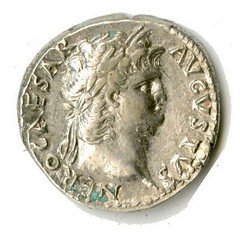

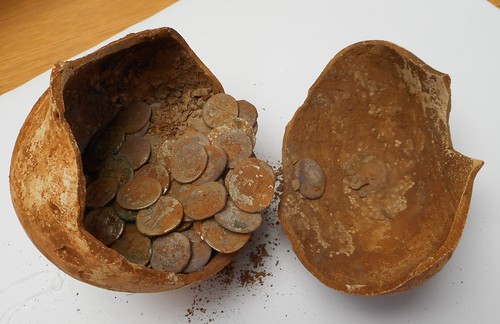
To read the complete article, see:
Look: Incredible old Roman coin hoard
found in Warwickshire (https://www.coventrytelegraph.net/whats-on/arts-culture-news/gallery/look-incredible-old-roman-coin-15854808)
SECRET DRAWER FIND: 14TH CENTURY GOLD COIN
Sometimes you really CAN find some serious cash between your couch cushions, or say, in a secret drawer of a desk. HereI's a great find story from London. -Editor
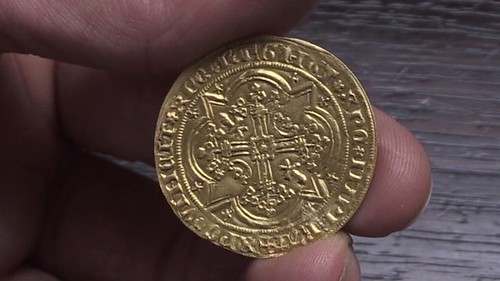
A gold coin, estimated to be worth up to £3,000, has been found inside a hidden drawer of a wooden bureau valued at just £60.
The Raymond IV Prince of Orange Franc A Pied coin dates back to 1365, making it more than 650 years old.
Its guide price is £1,200 to £1,800, but experts think it could sell for as much as £3,000.
Amy Clapp, 37, from Derbyshire, was given the 20th century George II-style bureau by a long-lost distant cousin. It is estimated to be worth £60 to £80.
Mrs Clapp said: "I can't even remember meeting my great cousin but I received a letter from a solicitor before Christmas informing me that I'd been left various items of furniture. Apparently, the will was written when I was 13 years old."
Mrs Clapp had no idea the hidden drawer, which had kept the 14th century French gold coin hidden, even existed until she took it to an auctioneers.
The coin was discovered by furniture valuer Edward Rycroft, at Hansons Auctioneers, London.
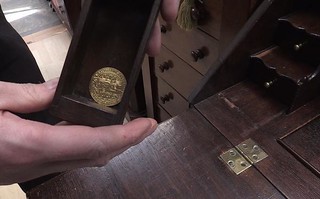 During an inspection he found three secret drawers within the bureau, one containing the 22ct gold
coin.
During an inspection he found three secret drawers within the bureau, one containing the 22ct gold
coin.
Mr Rycroft said: "I know bureaus like this often have tiny, secret drawers - sometimes called coin drawers - so I always check them just in case.
"But in 10 years of valuing furniture I have never found anything in them - until now."
QUICK QUIZ: What famous U.S. coins were once discovered in a similar hidden desk drawer? -Editor
To read the complete article, see:
Auctioneer strikes gold with ancient coin
hidden in secret drawer (https://www.itv.com/news/2019-02-18/auctioneer-strikes-gold-with-ancient-coin-hidden-in-secret-drawer/)
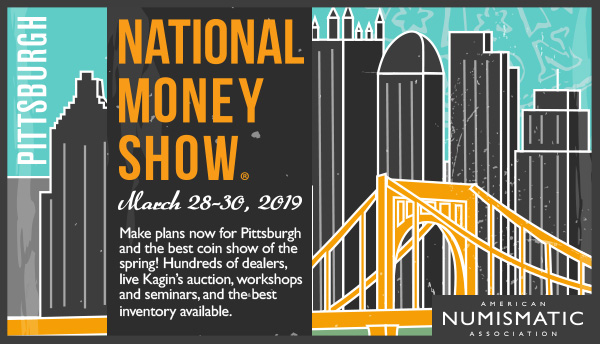
NUMISMATICS IN VICTORIA
The British television drama series Victoria stars Jenna Coleman as Queen Victoria. Readers note some numismatic content in recent episodes. -Editor
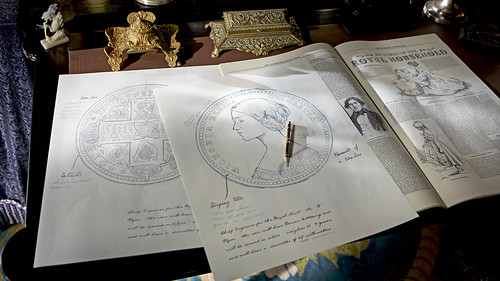
The "Godless Florin" was AlbertI's fault
Alan Meghrig writes:
The episode has two scenes about coin(s)… 'patterns'(?) being handled while discussing the design. A 'Decimal' value system (?) as in Europe … and showing of the crown. The second scene a discussion about the lack of part of the title of the monarch.
To read the complete article, see:
Fact or Fiction: Inside Episode 6
(https://www.pbs.org/wgbh/masterpiece/specialfeatures/victoria-s3-e6-fact-or-fiction/#)
Chip Howell writes:
Last SundayI's episode, "A Quartet of Coburgs" featured a short segment on the discussion & naming of the new one-tenth pound/two shilling piece & the idea of it as a first step towards decimalization--about 5 minutes into the show...
To read the complete article, see: Victoria (UK TV series) Series 3 (2019) (https://en.wikipedia.org/wiki/Victoria_(UK_TV_series)#Series_3_(2019))
Thanks, guys. -Editor
THE STOCKBRIDGE STELLA ORIGIN STORY
Martin Kaplan passed along this lot from the upcoming Heritage March 14-16 auction that has its own interesting discovery story. Thanks. -Editor
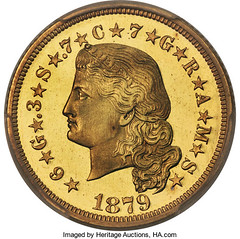
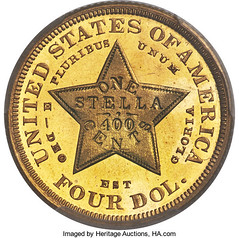
The series of events that led to the discovery of this Premium Gem Cameo stella is straight out of a Hollywood movie.
According to her niece and nephew, Aunt Mary had always been generous, sharing her time and energy as a community leader, and helping to pay for school and other necessities when family members were in a bind. But she was equally careful, never spending extravagantly on herself and always living within her means. She lived in the same understated home for half a century.
As Aunt MaryI's health deteriorated, she warned her niece, who made regular trips up to Stockbridge: "Be careful before giving things away." Without being explicit, she put her niece on notice. Still, after Aunt MaryI's death it came as a total surprise that the quaint, colonial house nestled in the Berkshire Mountains contained a variety of often well-hidden antiques, paintings, and other valuables, including a bottle of rye whisky that had been casked in 1863 and bottled in 1913, and a landscape painting by renowned 19th century French artist, Jean-Baptiste-Camille Corot.
The present coin was found in an old safe among a pile of coins, including a couple of Spanish gold cobs and American double eagles. Aunt Mary had never made any mention of the coins, so the executors of the estate brought the cache to a local coin shop for an appraisal. Having no idea what their coins were worth, they were delighted when the coin dealer jumped out of his chair and exclaimed that he had never handled a stella in more than 30 years. As it turned out, Aunt MaryI's niece and nephew had inherited a significant rarity.
Unfortunately, nothing is known about the prior history of this coin. The current consignors believe it may have been accepted as payment from a client by their uncle, MaryI's husband, who owned his own business.
To read the complete lot description, see:
1879 $4
Flowing Hair, Judd-1635, Pollock-1833, JD-1, R.3, PR66 Cameo PCGS....
(https://coins.ha.com/itm/proof-four-dollar-gold-pieces/1879-4-flowing-hair-judd-1635-pollock-1833-jd-1-r3-pr66-cameo-pcgs/a/1293-3255.s)
U.S. MINT ENDS PRODUCTION OF 90% SILVER COINS
A February 20, 2019 article by Mike Unser on CoinNews.net highlights a change from the U.S. Mint that you might not have heard about. -Editor
 Say goodbye to the 90/10 mix of silver coins from the United States Mint. The
agency is now producing silver coinage to 99.9% purity.
Say goodbye to the 90/10 mix of silver coins from the United States Mint. The
agency is now producing silver coinage to 99.9% purity.
See the complete article online for more information. This isn't just a marketing decision - there are a number of benefits in the manufacturing process, including greatly increased die life, greatly reduced die cleaning time, less scrap and fewer customer returns. Interesting.
Old traditions die hard (no pun intended), but after over 200 years U.S. silver coins will no longer be made of coin silver. I did not find a definition of "coin silver" in the Newman Numismatic Portal dictionary, so hereI's what Merriam-Webster says. -Editor
coin silver noun
Definition of coin silver
: silver of the fineness legalized for coins (such as .900 fine in the U.S., .500 fine for Great Britain since 1920)
To read the complete dictionary entry, see: coin silver To read the complete article,
see:
U.S. Mint Ends Production of 90% Silver Coins
(http://www.coinnews.net/2019/02/20/u-s-mint-ends-production-of-90-silver-coins/)
HereI's a link to Coin WorldI's coverage. -Editor
To read the complete article, see:
U.S. Mint replaces 90 percent silver alloy with .999
fine silver (https://www.coinworld.com/news/us-coins/2019/02/us-mint-drops-90-percent-silver-composition.html)
THE EURO'S IMPACT ON NUMISMATICS
Lou Golino published an article on the Euro's impact on numismatics on the CoinWeek site February 20, 2019. HereI's a short excerpt. be sure to see the complete article online. -Editor
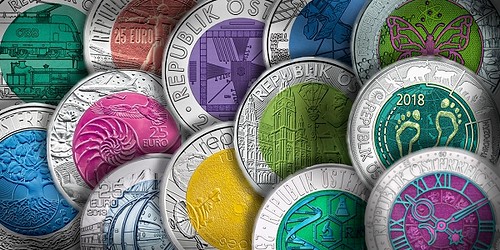
The euro has been an enormous boon to numismatics in Europe and beyond for two decades, resulting in an explosion of circulating and commemorative coins collected by millions of citizens in Europe and others in the U.S., Asia and elsewhere.
One measure of the number of new releases is that each year's annual Lighthouse catalog of euro coins sees an average increase of about 30 pages (with each page usually listing eight coins or sets) over the previous year, with the 2019 edition coming in at just under 700 pages. Another measure is the proliferation of blogs, Facebook pages, and websites devoted to collecting euro coins.
In fact, the impact of the euro on numismatics in Europe is a key reason why the European numismatic market is now believed to be larger than that of the United States in terms of collectors if not also sales - with a substantial chunk of that activity coming from collectors in Germany.
Since the euro's introduction, European mints have not only vastly expanded their offerings but have also been at the forefront of technological innovation, such as the introduction in 2016 by the German Mint of coins with a polymer ring.
To read the complete article, see:
The Coin Analyst: The Euro's Impact on
Numismatics After 20 Years (https://coinweek.com/world-coins/the-coin-analyst-the-euros-impact-on-numismatics-after-20-years/)
WOMEN'S SUFFRAGE MEDALLIC ART COMPETITION
AMSA is seeking designs for an upcoming medal commemorating women's suffrage (the right to vote) in the U.S. -Editor
 The American Medallic Sculpture Association (AMSA) is conducting a special art medal competition to commemorate
the 100th anniversary of women's suffrage in the United States (in 2020). The competition is open only to paid-up members of AMSA. The winner will receive
a $300 prize. All entries will be featured early in 2020 in the AMSA publication and on the AMSA web site, along with specifications, edition sizes, prices and
ordering information, so that medals can be ordered directly from the medalists starting early in 2020. AMSA asks entrants to indicate this information, along
with their snail mail, email and PayPal addresses.
The American Medallic Sculpture Association (AMSA) is conducting a special art medal competition to commemorate
the 100th anniversary of women's suffrage in the United States (in 2020). The competition is open only to paid-up members of AMSA. The winner will receive
a $300 prize. All entries will be featured early in 2020 in the AMSA publication and on the AMSA web site, along with specifications, edition sizes, prices and
ordering information, so that medals can be ordered directly from the medalists starting early in 2020. AMSA asks entrants to indicate this information, along
with their snail mail, email and PayPal addresses.
Submissions for medals to commemorate the 100th anniversary of women's suffrage in the United States, produced in 2019, should be sent to numismel@aol.com by December 31, 2019. Press releases will be sent out announcing the winner and directing people to all of the entries on the AMSA web site. Heidi Wastweet, President of AMSA, indicates that "This is a great opportunity for medalists to expose their talents to a large audience."
Founded in 1982, the American Medallic Sculpture Association (AMSA) works to encourage the creation, study and appreciation of the American Fine Art Medal. Members receive a quarterly full color publication detailing recent and upcoming events, galleries, conferences, etc. The medals created by members are featured on the AMSA web site. Dues are $40 within the USA, $50 elsewhere. To join AMSA or for further information, visit www.amsamedals.org .
The illustrated medal is one of the few created in the past commemorating women's suffrage in the U.S. It was issued in the 1970s by the Longines Symphonette in their Great American Triumphs series.
For the history of the term Suffrage, see:
What Does Suffrage Mean? (https://www.thoughtco.com/definition-of-suffragr-3530522)
ARIZONA ASSAY OFFICE INGOTS
The ALL ENGELHARD web site also covers certain non-Engelhard bars and ingots. ThereI's a new page on the Arizona Assay Office illustrating a couple dozen examples. HereI's an excerpt. -Editor
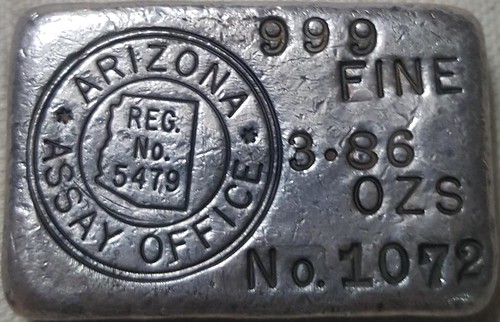
Arizona Assay Office ingots were reportedly produced for Paul Franklin by Jack Stone in 1969 out of his North First Street location in Phoenix, Arizona. These examples were reportedly produced in total mintage of 80 and in varying fineness of .720, .925 and .999 purity. The .725 and .925 examples are similar to each other in casting size but are distinctly different than the .995 and .999 examples. Additionally, the .995 and .999 examples were produced using two different casting moulds, with ingots S454 and S456 being of a larger and more shallow casting mould than the other examples. A few unique copper examples were also produced and are presented within this page among their silver counterparts.
There are currently fewer than 50 known Arizona Assay Office examples, at least 12 of which demonstrate a single border ring hallmark stamp.
To read the complete article, see:
ARIZONA ASSAY OFFICE (https://allengelhard.com/arizona-assay-office/)
Paul Franklin played a starring role in the famous "Franklin Hoard" affair of the last century. Karl Moulton wrote a book about it, so I passed this along to him for comment. Here are his thoughts. -Editor
The Arizona Assay Office bars were never considered part of the "Franklin Hoard", even though they first appeared at the same time as the Star Mining and F.G. Hoard gold bars, in late 1969.
Franklin, recently returned from an extended trip outside the U.S., was the distributor for the Jack Stone AAO bars with his new company, Arizona Silver Company. Stone wrote an introductory letter on AAO letterhead certifying his manufacturing of these bars. There was no cover up story associated with these, and were in the genre of the numerous private silver bars before the "Art Bar" craze of the early 1970I's.
StoneI's letter reads,
"20 Nov. 1969,
To Whom it may Concern !
I here by certify that the silver bars and Ingots stamped with the Arizona Assay Office stamp + Register #5479 were made under my supervision for distribution
by Arizona Silver Co; represented by Paul Franklin.
To clarify a small editing omission in my "John J. Ford, Jr. and the "Franklin Hoard" book, p.625, what is written is "The Arizona Assay Office bars were modern issues made primarily for Franklin by Jack Stone...".
It should have read, "The Arizona Assay Office bars were modern issues made primarily for distribution by Franklin by Jack Stone...". A copy of StoneI's letter can be seen earlier on p.588 in the John Ford/Franklin Hoard book.
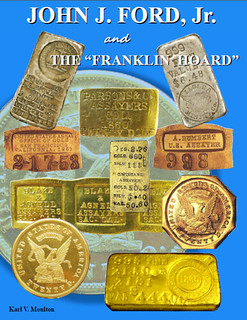 Hopefully, the proper
wording will get changed on the ALL ENGLEHARD web site page.
Hopefully, the proper
wording will get changed on the ALL ENGLEHARD web site page.
Some copies of KarlI's John Ford/Franklin Hoard book are still available for sale. Contact him at numiscats@aol.com . -Editor
To read the earlier E-Sylum articles, see:
AN UPDATE ON MOULTONI's FRANKLIN HOARD BOOK (https://www.coinbooks.org/esylum_v16n21a09.html)
BOOK REVIEW: JOHN J. FORD AND THE FRANKLIN HOARD
(https://www.coinbooks.org/esylum_v16n24a05.html)
BOOK REVIEW: JOHN J. FORD AND THE FRANKLIN HOARD
(https://www.coinbooks.org/esylum_v16n26a07.html)
$11 BILL: $10/$1 DOUBLE DENOMINATION ERROR
Martin Kaplan pointed out this great error note in the upcoming Lyn Knight March 2019 auction. Thanks. -Editor

Fr. 2011-B $10/$1 1950-A New York B-D Double Denomination
Grade: PMG Ch. XF 45
The rarest of the small size double denominations, and undoubtedly the most sought after. Who would ever think of an $11 bill! The combination of a $10 FRN and a $1 silver certificate back, surely makes for the most unusual combination recorded on a single issue. The error note expert, Harry Jones, estimates that only six of these have survived. As amazing as that seems, three pieces were available at the 1976 ANA. This statement was taken from the Hans Schulman auction description:
"In the spring of 1955, a charming young woman was surprised to note, after a few counts, that there were two different totals in her pay envelope - $120 at times and $111 when the bills were turned over. Close examination ferreted out the culprit, a bill with $10 on the face and $1 on the reverse. Mrs. O'Connor, the heroine of our tale, did a bit of checking, and subsequently received many offers of purchase for the misprinted bill. The bookkeeper who issued the pay envelope offered to take the bill back to the ManufacturerI's Trust Co. branch at 221 Fourth Avenue in New York City to exchange it for a "good" bill. This Mrs. O'Connor refused, preferring to hold it as a souvenir".
This $11 bill, a double denomination, is one of the rarest and seldom offered of the doubles. It is one of the most conservatively graded note I have seen.
Current Bid: $ 18,000.00
Estimate: ($ 30,000.00 - $ 60,000.00)
To read the complete article, see:
$10/$1 Double Denomination (http://www.lynknight.com/items/1121064)
THE TIN CAN CASE: WHO OWNS BURIED TREASURE?
Pablo Hoffman forwarded this very interesting, well written and illustrated article from Topic on a landmark court case on the issue of who owns finds of buried treasure in the U.S. Thanks! HereI's a short excerpt, but be sure to read the complete article online. -Editor
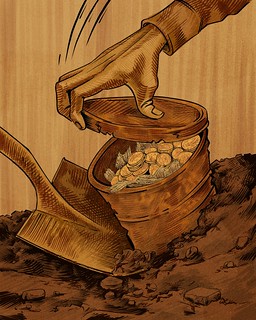 Deep under mounds of refuse and soil, Waldo discovered a rusted and sealed half-gallon fruit can. He was about to
toss the can into a container with the other trash, but the vessel, which felt unusually heavy, piqued his interest. After lifting the lid with a pickax, he
found several tightly packed tobacco sacks, full of five-, ten-, and twenty-dollar US gold pieces.
Deep under mounds of refuse and soil, Waldo discovered a rusted and sealed half-gallon fruit can. He was about to
toss the can into a container with the other trash, but the vessel, which felt unusually heavy, piqued his interest. After lifting the lid with a pickax, he
found several tightly packed tobacco sacks, full of five-, ten-, and twenty-dollar US gold pieces.
Chalmus suggested taking the cache home, but his older brother insisted on showing the treasure to Roberts. Perhaps Waldo was proud of the discovery, or maybe he anticipated receiving a big reward in return for his honesty and transparency. Regardless, he and his brother lugged the can over to the family's porch. "What you got?" asked Roberts. "A can of gold," the boys replied.
Concealed stashes like the one found in the chicken coop were not unusual in the late nineteenth century. Banks frequently failed during financial crises-there had been panics in 1837, 1873, and 1893, the year before the boys found the treasure-and depositors could lose everything they had, so many Americans hid money and valuables in or around their homes: in attics and cellars, in secret compartments, or in holes in the ground. Hiding or burying personal savings or treasure was also a way to protect it from robbers or law enforcement, particularly if the goods had been illegally acquired. In addition, a gold rush in Oregon in the 1850s-during which some prospectors made fortunes in the southwestern part of the state-created the possibility that lucky miners who hit pay dirt had hidden their earnings. Decades after the gold rush, when money could be dug right out of the earth, many people in the area still believed that "finders keepers" was the law of the land.
Nine years later, in 1903, Waldo and Chalmus, now 19 and 17-ages at which their accusations would carry credibility-engaged two lawyers and took legal action against the Robertses and their farming partner, P. B. O'Neil. The boys' mother, Minerva Danielson, agreed to act as a guardian ad litem in a lawsuit in which the brothers claimed rightful possession of the treasure and charged the landowners with wrongfully taking and keeping the money. Newspaper reporters learned of the lawsuit as soon as it was filed and called it the "Tin Can Case."
The case that the Waldo and Chalmus set in motion has been cited at least 17 times in legal decisions since 1904. "It's one of the leading cases on the question of found property," says Orth, who often calls it to the attention of students in his property-law classes.
The Danielson brothers' claim to possession of buried treasure was also echoed in a 2013 case, when a couple walking their dog found $10 million in gold coins buried on their property in rural Northern California. It was impossible to know who originally buried the money-the coins all dated from the 19th century-so possession of the treasure went to the couple, though they were also required to pay federal and state income tax on their find, roughly 47 percent of the coins' worth.
To read the complete article, see:
Who Owns Buried Treasure? (https://www.topic.com/who-owns-buried-treasure)
PETOLS: THE SILVER CURRENCY OF CANNABIS COUNTRY
Another article of interest from Topic is this one on an old proposed alternate currency in an isolated Northern California town. HereI's a short excerpt, but be sure to read the complete article online. -Editor
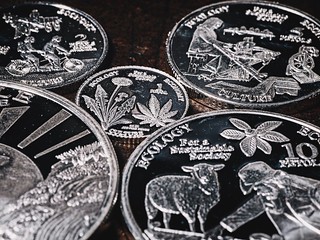 In 2007, a renegade climate scientist and Petrolia resident named Ken Young bet most of his own savings
to create the Petol (pronounced peh-toll), minting coins in pure silver in an effort to strengthen the self-sufficiency of the valley against the socioeconomic
upheaval he foresaw on the national horizon. Plenty of people have launched alternative currencies in this country, but Young's choice to use silver, a
precious metal with intrinsic value, set him apart from most. The Petol was a serious attempt to break away from government-backed money.
In 2007, a renegade climate scientist and Petrolia resident named Ken Young bet most of his own savings
to create the Petol (pronounced peh-toll), minting coins in pure silver in an effort to strengthen the self-sufficiency of the valley against the socioeconomic
upheaval he foresaw on the national horizon. Plenty of people have launched alternative currencies in this country, but Young's choice to use silver, a
precious metal with intrinsic value, set him apart from most. The Petol was a serious attempt to break away from government-backed money.
Despite some promising early sales, the coins struggled to gain traction, even among locals. Then, in February 2018, Young died of a brain tumor at the age of 76. His bold currency experiment may be destined to fade with him. Still, I wanted to better understand what the Petol said about the Mattole Valley and its people. Why would a community want to stop using the federal government's legal tender?
He created six coins, available in denominations of 20, 10, 5, 2, and 1, with a half-Petol in brass. A single Petol was priced around $2, meaning a 10 Petol (one ounce) piece went for $20. They featured beautiful engravings dedicated to "a sustainable society" (windmills and hydropower wheels, farming and bicycle transport, a pot leaf), ringed with the words "ecology," "economy," "culture": three factors Young believed were essential for an autonomous community.
But much to his disappointment, the Petrolia general store, the lone place to buy provisions in town, would not tender the currency. "It was just too hard to deal with-always having to check the price of silver, making calculations, and so on," says a longtime store employee who does not want to be named. But still, she adds, the Petol was "real money, no question."
To read the complete article, see:
The Silver Currency of Cannabis Country
(https://www.topic.com/the-silver-currency-of-cannabis-country)
DISCOVERING DNA IN OLD BOOKS
HereI's one for the bibliophiles among us - an excerpt from an a February 19, 2019 article in The Atlantic about a lab investigating the DNA found in (very) old books. -Editor
 It was in
the archives of the Archbishop of York that Matthew Collins had an epiphany: He was surrounded by millions of animal skins.
It was in
the archives of the Archbishop of York that Matthew Collins had an epiphany: He was surrounded by millions of animal skins.
Another person might say they were surrounded by books and manuscripts written on parchment, which is made from skins, usually of cows and sheep. Collins, however, had been trying to make sense of animal-bone fragments from archaeological digs, and he began to think about the advantages of studying animal skins, already cut into rectangles and arranged neatly on a shelf. Archaeologists consider themselves lucky to get a few dozen samples, and here were millions of skins just sitting there. "Just an obscene number," Collins told me, his voice still giddy at the possibilities in their DNA.
In recent years, archaeologists and historians have awakened to the potential of ancient DNA extracted from human bones and teeth. DNA evidence has enriched-and complicated-stories of prehistoric human migrations. It has provided tantalizing clues to epidemics such as the black death. It has identified the remains of King Richard III, found under a parking lot. But Collins isn't just interested in human remains. He's interested in the things these humans made; the animals they bred, slaughtered, and ate; and the economies they created.
Collins splits his time between Cambridge and the University of Copenhagen, and it's hard to nail down exactly what kind of -ologist he is. He has a knack for gathering experts as diverse as parchment specialists, veterinarians, geneticists, archivists, economic historians, and protein scientists (his own background). "All I do is connect people together," he said. "I'm just the ignorant one in the middle."
Pulling the project together though, was far from easy. -Editor
The National Science Foundation would tell him that they didn't work on livestock, and he should call the USDA. He'd talk to the USDA, and they'd tell him that medieval books fell under the purview of the National Endowment for the Humanities. He'd talk to humanities people, and they'd say, Genetics research? That already has all the money. "I really did get on this constant loop of everyone wanting me to call someone else," Stinson says.
Even once the project got underway, there were hurdles. -Editor
It didn't take long for the group to hit their first culture clash. In science and archaeology, destructive sampling is at least tolerated, if not encouraged. But book conservators were not going to let people in white coats come in and cut up their books. Instead of giving up or fighting through it, Sarah Fiddyment, a postdoctoral research fellow working with Collins, shadowed conservationists for several weeks. She saw that they used white Staedtler erasers to clean the manuscripts, and wondered whether that rubbed off enough DNA to do the trick. It did; the team found a way to extract DNA and proteins from eraser crumbs, a compromise that satisfied everyone.
Congratulations to Collins for his perseverence. Linked below are a couple earlier E-Sylum articles about attempts to recreate smells of the past from books. -Editor
To read the complete article, see:
The Lab Discovering DNA in Old Books
(https://www.theatlantic.com/science/archive/2019/02/dna-books-artifacts/582814/)
To read the earlier E-Sylum articles, see:
STOP AND SMELL THE BOOKS (https://www.coinbooks.org/v20/esylum_v20n10a32.html)
A WHIFF OF HISTORY FROM BOOKS (https://www.coinbooks.org/v20/esylum_v20n16a37.html)
THE OTTO PENZLER COLLECTION
HereI's one more for the bibliophiles, but it contains a lesson for all collectors. I've always felt that a sufficiently advanced collector is indistinguishable from a dealer. To build a great collection, one has to see and handle a large amount of material, and thereI's no better way to do that that to become a dealer, be it in books, coin books, coins, or whatever strikes your collecting fancy. Some of my best acquisitions came when I was actively buying everything from individual books to complete numismatic literature libraries.
HereI's an excerpt from the February 21, 2019 issue of Historical News from Heritage about Otto Penzler and his collection of mystery fiction. I think collectors of all stripes will appreciate the story. -Editor
 It was just after college
that I started to collect. Although I earned only $42 a week ($37 after taxes), I had decided that I wanted to collect English and American literature - all of
it. Fortunately, a wise old bookseller convinced me to narrow my vision and, after a couple of years of specializing in British adventure fiction and World War
I poets, I focused on mystery fiction.
It was just after college
that I started to collect. Although I earned only $42 a week ($37 after taxes), I had decided that I wanted to collect English and American literature - all of
it. Fortunately, a wise old bookseller convinced me to narrow my vision and, after a couple of years of specializing in British adventure fiction and World War
I poets, I focused on mystery fiction.
Since I enjoyed reading the books, they seemed a good niche for collecting as there was very little competition for books in that field. New York CityI's famous 4th Avenue booksellers' row (with more than sixty bookshops within a few blocks of each other) flourished back then and it was easy to find a half-dozen first editions in collectable condition within my five-dollar-a-week budget. As my salary increased, so did the quality of the bookshops I came to know, and the number of shelves I had to erect to hold ever more books.
In 1979 I opened the Mysterious Bookshop in midtown Manhattan and broke what I had been told was the cardinal rule of bookselling-never compete with your customers. We sold new and used books, like most mystery specialty stores in the country, but I was mostly interested in first editions and the people who collected them. Thousands of books came through the door some months and all purchases were brought into my office where they were sorted into two stacks: one for the store, one for my private library.
My office was beautiful! It had floor-to-ceiling shelves that I calculated could hold nine thousand volumes which, I was certain, was more than I'd ever need. Just to be insanely safe, I had them built wide enough to be two rows deep and, since book collections are like gas, expanding to fill the space available, they eventually became inadequate as the number of volumes approached twenty thousand. With no end to the torrent of new additions in sight, I built a large house in the country to hold them. The library wing of the house would comfortably contain about seventy thousand volumes so, as the collection hit the sixty thousand mark, there was still plenty of space to grow. In the year 2000, I decided to stop collecting every new book published, as they were rarely of bibliographical interest, and I focused on upgrading titles already on the shelves and filling in the many missing titles. I owned most of the major titles and therefore concentrated on finding the obscure and arcane volumes that had proved elusive, with only moderate success. Particularly in the area of paperback originals.
Every first edition that came into the store was compared against my copy. I upgraded books constantly, being obsessed with having the best possible copy, as well as checking for variants, which I thought important for bibliographical purposes. It is not hyperbolic to state that some titles were improved up to a half-dozen or more times, which is why the condition of the books in my collection are, mainly, in outstanding condition. I had an advantage over most collectors in that I saw so many books and because I had a convenient way of dispersing my unwanted copies.
LOOSE CHANGE: FEBRUARY 24, 2019
Here are some additional items I came across in the media this week that may be of interest. -Editor
The First War Between Jews and Romans
HereI's an article from Künker on coin of the first war between Jews and Romans. -Editor
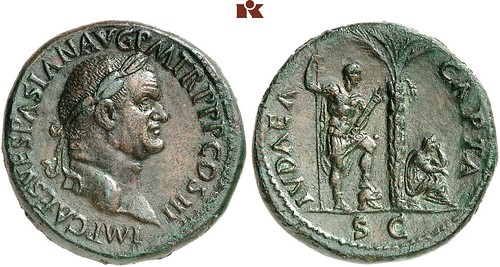
On March 11, 2019, the Osnabrück auction house Künker is auctioning off a sestertius of Vespasian, with a well-known topic on its reverse side. The Emperor stands as triumphator to the right with spear and parazonium (= a dagger that was used as a mark of rank in the legions), resting his foot on a helmet. In front of him, a crying woman is crouching underneath a date tree, which was understood as a sort of coat of arms for the province of Judea. The circumscription reads IVDAEA CAPTA, meaning Judea has been captured.
This iconic coin was struck in 71 AD in Rome on occasion of the triumphal procession of Vespasian and Titus after their victory over the Jews.
To read the complete article, see:
The first war between Jews and Romans
(https://www.kuenker.de/en/information/presseinformationen/
aktuelle-mitteilungen/228)
Indian Queens in Numismatics
HereI's an article from The Daily Star on Indian Queens in numismatics. -Editor
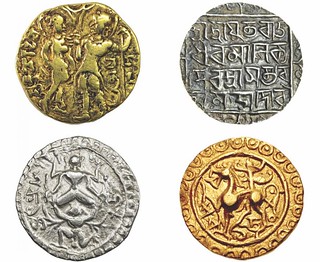 Coins spark
questions, and curiosity too.
Coins spark
questions, and curiosity too.
Case in point: the coins of the Indian subcontinent, issued by certain rulers, where names of their queens also appear in the legends ('legend', in numismatics, means inscriptions).
These coins may make you raise an eye-brow: it is understandable why reigning kings would often leave their mark on coins, but what would have motivated them to include the names of their queens as well? After all, those queens were not officially rulers themselves.
"This pattern is rare; the mention of queens in coins is very uncommon," said Shahrier Ferdaus, an avid coin collector.
To read the complete article, see:
In the name of the
Queen (https://www.thedailystar.net/supplements/28th-anniversary-supplements/the-lifestyle-parenthesis/news/the-name-the-queen-1706182)
Where does fake movie money come from?
Howard Berlin forwarded this great article about movie prop company RJR Props and their fake movie money. Check it out. -Editor
 I just got out of a
meeting with the Secret Service. I'm still in the parking lot," said Rich "RJ" Rappaport at the beginning of our phone interview. The reason
for the meeting? Some discussion about fake money.
I just got out of a
meeting with the Secret Service. I'm still in the parking lot," said Rich "RJ" Rappaport at the beginning of our phone interview. The reason
for the meeting? Some discussion about fake money.
Rappaport is the founder of Atlanta-based RJR Props, a movie prop company that specializes in faux cash for filming. His money was used in "The Wolf of Wall Street," "The Fast and the Furious," the Netflix series "Ozark" and in 50 Cent and Kendrick Lamar music videos. But printing money is a delicate business, which is why he stays in touch with the men in black.
"I wanted clarity about laws and regulations. Most other companies that make prop money are actually producing illegal prop money, and that can get a show shut down and someone fined and jailed."
To read the complete article, see:
Where does fake movie money come from?
(https://edition.cnn.com/style/article/rjr-props-fake-money/index.html)
Collector Murdered Over Beatrix Potter 50p Coin
The craze for collecting Royal Mint modern commemoratives led to a manI's death this week. HereI's an excerpt from an article from the Mirror. -Editor
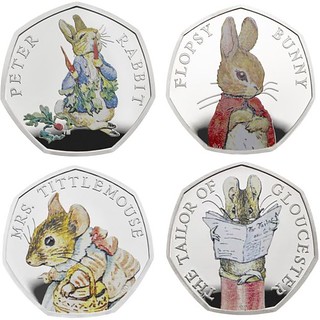 A coin
collector was stabbed to death in his home by a fellow enthusiast who wanted his limited edition Beatrix Potter 50p pieces, a court heard.
A coin
collector was stabbed to death in his home by a fellow enthusiast who wanted his limited edition Beatrix Potter 50p pieces, a court heard.
Gordon McGhee, 52, was found dead with 14 knife wounds including some to his face in his flat, which the attacker had allegedly tried to burn down before fleeing.
Danny Bostock, 33, who knew Mr McGhee and shared his hobby of collecting coins was later arrested.
Much of McGheeI's coin collection including the prized Beatrix Potter coins were never recovered, the court heard.
He said Bostock wanted the coin collection having swapped his own Beatrix Potter coins with other people in the area in the hours before the alleged murder in Colchester, Essex in August.
He said: "It was in the early hours of Wednesday, August 22 last year that this defendant Danny Bostock went to the home of Gordon McGhee.
To read the complete article, see:
Coin collector I'stabbed to death by fellow enthusiast over
rare Beatrix Potter 50p' (https://www.mirror.co.uk/news/uk-news/coin-collector-stabbed-death-fellow-14019823)
To read earlier E-Sylum articles, see:
2018 ROYAL MINT BEATRIX POTTER COINS RELEASED
(https://www.coinbooks.org/v21/esylum_v21n08a32.html)
HOMELESS MAN GIVEN VALUABLE BEATRIX POTTER COIN
(https://www.coinbooks.org/v20/esylum_v20n02a34.html)
Dwight Manley Found his Birth Father
For a Good News story, hereI's a great article from the Orange County Register and The Press Enterprise of Riverside County, CA about how numismatist Dwight Manley found his birth father through a DNA test. -Editor
The connection between the two pairs of blue eyes is one story among thousands generated in an age of affordable genetic testing and deep-rooted genealogy websites, unknown origins resolved with a saliva sample and a DNA kit dropped in the mail.
The discovery likely would be of little interest outside of family and friends. Except for who they are.
The son: a rare coin expert and successful sports agent who represented basketball bad boy Dennis Rodman in his multi-million dollar heyday with the NBA champion Chicago Bulls and other big-name players.
And the father? One of the most well-known elected officials in Los Angeles history...
To read the complete article, see:
Using DNA tests, Dwight Manley
found his birth father (https://www.pe.com/2019/02/21/using-dna-tests-dwight-manley-found-his-birth-father)
FEATURED WEB PAGE: TOP 11 WEBSITES
This weekI's Featured Web Page is an article by About.com (now Dotdash) Coin Guide James Bucki listing the Top 11 Websites for Coin Collectors and Enthusiasts.These top coin related websites were selected based on the content and reliability of the information that they represent. Additionally, you will be able to choose amongst a variety of different types of sites that will give you the best variety of information and knowledge.
https://www.thesprucecrafts.com/best-coins-sites-on-the-web-3898464


